
Comic Book Historians
As featured on LEGO.com, Marvel.com, Slugfest, NPR, Wall Street Journal and the Today Show, host & series producer Alex Grand, author of Understanding Superhero Comic Books (with various co-hosts such as Bill Field, David Armstrong, N. Scott Robinson, Ph.D. and Jim Thompson) and guests engage in a Journalistic Comic Book Historical discussion between professionals, historians and scholars in determining what happened and when in comics, from strips and pulps to the platinum age comic book, through golden, silver, bronze and then toward modern
Support us at https://www.patreon.com/comicbookhistorians.
Read Alex Grand's Understanding Superhero Comic Books published by McFarland & Company here at: https://a.co/d/2PlsODN
Series directed, produced & edited by Alex Grand
All episodes ©Comic Book Historians LLC.
Comic Book Historians
Michael Dooley, Adjunct Professor of Comics with Alex Grand & Jim Thompson
Alex Grand and co-host Jim Thompson interview Michael Dooley, Adjunct Professor of Comics and Animation History at Pasadena’s ArtCenter College of Design and Print Magazine Contributing Editor for the past 20 years. Born in 1948, he discusses his youth as a New Yorker, reading Mad Comics and following the careers of Harvey Kurtzman and his disciples, Robert Crumb and Art Spiegelman. He earned his Design Degree at Pratt, entered his feld of graphic design, and launched a career teaching Comic Art history as well as curating Museum exhibits on the topic. He was involved with Comic Fandom in the ’80s, contributing to The Comics Journal. In this episode he covers a variety of topics, including Kurtzman, Steranko, Sienkiewicz, magazine cartoons, editorial cartoons, political comics, comic strips, adventure comics, alternative comics, graphic novels, and the profession and business of Comics. He also discusses his ArtCenter lectures, which include guests like Howard Chaykin and Bill Sienkiewicz, as well as an updating of his 2005 book, The Education of a Comics Artist. Plus, he recommends great comic academic sources like the Comic Book Historians podcast and YouTube channel videos, wink wink ;). Images used in artwork ©Their Respective Copyright holders, CBH Podcast ©Comic Book Historians. Thumbnail Artwork ©Comic Book Historians. Support us at https://www.patreon.com/comicbookhistorians
Face Your EarsExplore home recording and music creation with Rich and Justin on 'Face Your Ears'!
Listen on: Apple Podcasts Spotify
Alex Grand and Jim Thompson interview Michael Dooley, Professor of Comics and Animation History at Pasadena’s ArtCenter College of Design and Print Magazine Contributing Editor for the past 20 years. Born in 1948, he discusses his youth as a New Yorker, reading Mad Comics and following the careers of Harvey Kurtzman and his disciples, Robert Crumb and Art Spiegelman. He earned his Design Degree at Pratt, entered his feld of graphic design, and launched a career teaching Comic Art history as well as curating Museum exhibits on the topic. He was involved with Comic Fandom in the ’80s, contributing to The Comics Journal. In this episode he covers a variety of topics, including Kurtzman, Steranko, Sienkiewicz, magazine cartoons, editorial cartoons, political comics, comic strips, adventure comics, alternative comics, graphic novels, and the profession and business of Comics. He also discusses his ArtCenter lectures, which include guests like Howard Chaykin and Bill Sienkiewicz, as well as an updating of his 2005 book, The Education of a Comics Artist. Plus, he recommends great comic academic sources like the Comic Book Historians podcast and YouTube channel videos, wink wink ;). Images used in artwork ©Their Respective Copyright holders, CBH Podcast ©Comic Book Historians. Thumbnail Artwork ©Comic Book Historians. Support us at https://www.patreon.com/comicbookhistorians
Alex Grand:
Welcome again to the Comic Book Historians podcast with Alex Grand and Jim Thompson. Today we have a special guest, Michael Dooley. Michael is a professor at Art Center College of Design where he teaches design, history of comics, and animation. Beginning in 1991, Michael was a contributing editor for the graphic design magazine Print. Prior to that he wrote for Amazing Heroes and the Comics Journal. He directed programming and hosted events for the Masters of American Comics exhibit in Los Angeles in 2005, and co-edited one of the essential books on comic studies, The Education of a Comic Artist.
Alex Grand:
Education of a Comic Artist brings together many stars in comic history to discuss their viewpoint, even their corner of the vast multidimensionalism of comic books. It’s a great intro for people to realize that comics come in many forms, from editorial strips, books, novels, production to design, to art, to writing, to editing and various genres, et cetera. Michael Dooley, thanks for joining us today.
Michael Dooley:
Thank you very much. I’m so happy to be here with you two.
Jim Thompson:
What we always do with the podcast, Michael, which you probably already know, is that because you’re a good listener.
Alex Grand:
Actually, you listen to our podcast actually, in your spare time?
Michael Dooley:
In my spare time, yeah. And I can go on record as saying that Comic Book Historians is absolutely my favorite podcast for many reasons. So yes.
Alex Grand:
Oh, that’s awesome. We appreciate that very much.
Jim Thompson:
I know you were born in New York, I know you went to Pratt, I know you moved to LA at some point, but give us a little more detail about all of those things.
Michael Dooley:
Let’s see, at some point means 1974. that’s when I traveled cross-country in a Tercel and settled in the LA area. So in ’75 I started going to San Diego Comic-Con. Earlier than that, flash back to me being two years old. That’s when I started reading comics. I know that’s a Comic Historians Podcast question. So, at age two I was looking at, and eventually reading, comics. And at age seven I fell in love with Harvey Kurtzman because I bought one of his MAD comics. So that’s it in a nutshell, in terms of getting my early start in comics.
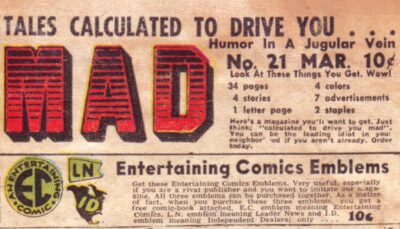
Alex Grand:
And the important part of that is it introduced you to comedic social criticism. Is that correct?
Michael Dooley:
That is correct, yes, definitely. And it pretty much was extremely formative in my life. Just to get personal for a quick bit, when I was seven years old, my mother and father got divorced. My dad left. So actually, Harvey was my surrogate father to a large extent in terms of forming my sensibility, for which I’m forever grateful.
Alex Grand:
And this was through your reading his work, right? That’s through-
Michael Dooley:
Through the comic. It’s picking up-
Alex Grand:
Through the comic?
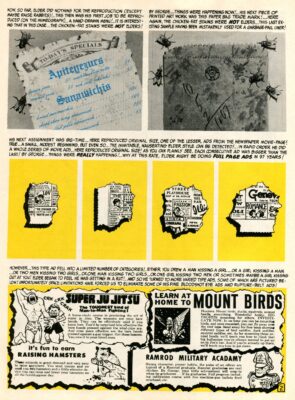
Michael Dooley:
Yeah. It’s picking up MAD number, was it 22? [21] It was the one where they did the Johnson and Smith ad parody on the cover. And the first story was Poopeye, and it was one of those things that was such a quantum leap from Little Lotta and Baby Huey and the rest of it. In its way, it’s like how Art Spiegelman and Bob Crumb talk about the Basil Wolverton MAD being a formative, mind blowing experience. And for me that was that. It was just- I spent the longest time reading that cover, over and over, and just fascinated that-
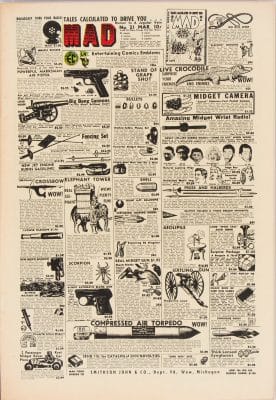
It was one of those things where, because it was so meta from the very beginning, it’s like, “Okay I’ve seen these ads inside the comic and here it is in front. Only it’s not, really.” Which actually made me start to realize something: “Oh, there are actually people, there’s a sensibility behind this.” And it’s like, “Okay, somebody is writing this, somebody’s drawing this. It’s not just coming off the presses because somebody pressed a button.” So it was really formative and in that way, in the sense that, it piqued my interest in graphic design before I knew what the word graphic design meant.
Alex Grand:
It’s a crafted art form by people.
Michael Dooley:
Right. “And now I are one,” as they say. [laughter]
Jim Thompson:
So Michael, were you aware of like the name Kurtzman? Were you able to see, like, “Oh, that’s Will Elder, that’s Kurtzman, That’s John Severin.” I mean, were you noticing the different styles at that point?
Michael Dooley:
From the first issue I was, I was noticing because there was every- each one of them had such a distinctive- There was Wally Wood’s “On the Waterfront”, and Elder did the Poopeye, and then there was Jack Davis in there as well. You know, they were so distinctive that, that was part of that whole visual education that I was getting at that tender age.
Michael Dooley:
And then, of course, ol’ Harv was nice enough to put out “The History of Will Elder” comic.
Jim Thompson:
Oh yeah. That definitely makes it more convenient. Sure.
Michael Dooley:
Yeah. Ol’ Harv was really coming along at the right time all over the place, there. And so, as you can see, I’m gushing with the admiration here. He was my first superhero.
Jim Thompson:
That Will Elder piece is so sophisticated. I mean, if you think that they’re writing for 10 year olds, it’s impossible to reconcile that with that whole comic bit. That was just so brilliant.
Michael Dooley:
Yeah. Yeah. The fact that Poopeye is running into Tarzan, and Mammy Yokum, and Superduperman, and the rest of it, it was this revelation. Come to think of it, I don’t know if I’ve ever spent that long looking at a 32-page comic, that sort of thing. And of course the eyeball kicks that he put in as well. So, yeah. That was definitely a revelation.
Jim Thompson:
Were you aware that they were also working in other genres in EC’s line of comics, or were you just interested in the humorous stuff at this point?
Michael Dooley:
At this point, I just knew about the humor stuff. Later on, I became familiar with the entire EC line, but at that point, at the tender age of seven, I wasn’t particularly tuned into Ghastly and the rest of it. So, I was happy to do that. And then there were the Get Lost: Andru and Esposito, and the rest of them. Panic, out of Feldstein’s factory. So that was what got me by for a while, yeah.
Alex Grand:
Did Two-Fisted Tales, Frontline Combat, did those affect you in any way?
Michael Dooley:
Oh yeah, I would definitely say so, in the sense that it was, again, part of that whole underground scene that came along. I was being- Well, I guess, I believe I’m the same age as Spiegelman. It was one of those things where Harvey went on with Trump and Humbug and Help. So after MAD changed, I was that well-aware to start looking around for his other stuff, which of course led me back into comics like Two-Fisted Tales and Frontline Combat.
Alex Grand:
I see. So it was more retroactively you went back to that stuff?
Michael Dooley:
Yeah. Yeah. And they were the first, because I was still fairly young at the time. So by the time I was involved in Vietnam War protests, I had already had that whole sensibility formed, again from, whatever, [chuckles] “Dad the Second.”
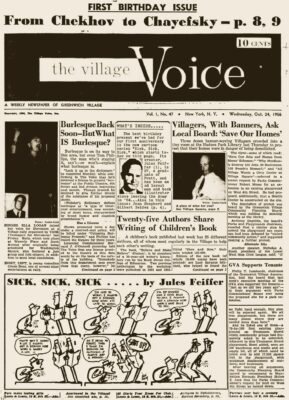
Jim Thompson:
So did Feiffer become your next big hero, or were the ones in between?
Michael Dooley:
Wow, you are so shrewd, Jim. There was the Village Voice that came along, and so in the late ’50s I started tuning into Feiffer in the front of the newspaper, and eventually got around to Paul Krassner’s The Realist, the rest of it, and that sort of thing. But yeah, the Feiffer newspaper comics. But before then there were the- I mean, Feiffer was a special feature in the Village Voice. but in terms of newspaper comic strips, I was super-addicted to that also, from a fairly early age. So that was mind expanding in that way.
Michael Dooley:
That was pretty much my introduction to the various other genres. So it’s like, when I was reading Poopeye, I was already aware that it’s- Li’l Abner was on the front page of one of the newspapers. There were about five Sunday newspaper supplements that were comics in New York at the time. Luckily, every Sunday I would go over to my mom’s mother- My grandmother would get all the papers, and so my brother and I would just spend the entire visit- most of the visit over there- getting familiar with Dick Tracy, he was on the cover of another one, and all the other comics. So that was also supplementing my education.

Michael Dooley:
And back then it was pretty much, I would read every single comic indiscriminately, from beginning to end. Y’know, I had my favorites. But yeah: newspaper comic strips. Imagine- That’s how old I am, that I can talk about being able to spend a an hour or two with Sunday comic supplements.
Alex Grand:
Right, that’s great. And then you mentioned the Paul Krassner’s Realist, just for the audience, that was from 1958, and you discovered that in ’65 when you’re at Pratt studying design, I think, right?
Michael Dooley:
Yes, exactly. Wow. Okay.
Alex Grand:
I listened to you, yeah. [Michael laughs]
Jim Thompson:
What made you go to Pratt? Like at some point did you say, “I want to be a comic book artist,” at some point did you say, “I just want to go into design?” What was your artistic trajectory at this point?
Michael Dooley:
Okay, great question, thanks. Just maybe even wrap up or do a transition here from Kurtzman. We were talking about the newspaper comics. One of my absolute favorite newspaper comics among those in the 1950s, one that I went to first was Smokey Stover. I realize in retrospect that those eyeball kicks that Will Elder was providing, actually the groundwork was laid by Bill Holman. I’m so thrilled about the Screwball book that came out this past year.
Alex Grand:
Yeah.
Michael Dooley:
Yeah. So the comics were definitely part of it. And one of the things about going over to my grandmother’s to read the comics was it was a gathering place for all of my mom’s relatives, and she had several sisters and brothers. It’s a Catholic family. [chuckles] And they brought their kids as well.
Michael Dooley:
So, I got to hang out on those Sundays with my cousin, my mother’s sister’s son, one of her sons, named Steve Degnen. And he was going to Pratt. At the time, I was going to Holy Cross High School in Queens and he was talking about Pratt Institute. And I really started thinking along the lines of that even more seriously when – If I can just do this real quick, a little incident that happened in high school was: there were brothers and lay teachers there. So I took Latin, that sort of thing. But there was this one teacher who was very physical.
Michael Dooley:
It’s early 1960s. There was no problem – well, even before that, in the ’50s, going to Catholic grade school – no problem with the nuns beating the shit out of you. But that happened even with the brothers and the lay teachers in high school. So one time, I was in, I think it was a geography class. I never saw the sense of geography, and this was even before GPS. It’s like, “Nobody needs to know that, unless they really care about the principal export of Ecuador”. [Alex chuckles]
Michael Dooley:
And so I was doodling in my notebook instead of taking notes, and the teacher was realizing, just from the way my hand was moving, that I was not hanging onto his every word. So he came down and he looked at these cartoons I was drawing, because again, it was that influence from reading the Sunday funnies and whatnot. And I thought for sure I was just about to get my head smashed into a wall. But instead, what he did was, he picked up my notebook, went to the front of the class, held it up to the rest of the class, and he said, “You know, Mr. Dooley is very lucky. Some people go through their entire lives without knowing what they want to do, and Mr. Dooley has already found art as his calling”.
Advertisement
Michael Dooley:
And I went, “Oh really?” But then, just, something clicked. That was a turning point, and then after that I started asking Steve more and more questions about what’s this going on with Pratt? And so, 1965 to ’70, I was in Pratt. Steve graduated from Pratt with an industrial design degree, and he was hired right out of school by Ford. They took him to Detroit, the rest of it, that sort of thing. And he was designing cars.
Michael Dooley:
And of course, being a teenager in the late 1960s was, of course, transformative. So, even though I was on an industrial design track, at that time I was finding out all sorts of other things, in addition to counter-cultural comics and the rest. It was also reading Unsafe At Any Speed, by Ralph Nader, before he became a Presidential election spoiler, back when he was a consumer advocate. And I was like, “This is the kind of crap that’s going on with the Pinto and the rest”. So the whole idea of working in industrial design, working for those kinds of corporations that I was protesting, is a part of my rebellious Pratt years. Anyway, long-short is I decided I wasn’t going to be part of industry. Actually, my first job out of school was as a photographer because I was doing freelance photography to pay my rent. I got hired by ABC to go down to photograph the Johnny Cash show after I graduated.
Alex Grand:
Oh, wow. That’s great.
Michael Dooley:
So I did that for a while, and then my career pinballed. My trajectory has been somewhat curvy, but that’s basically the answer to Jim’s question.
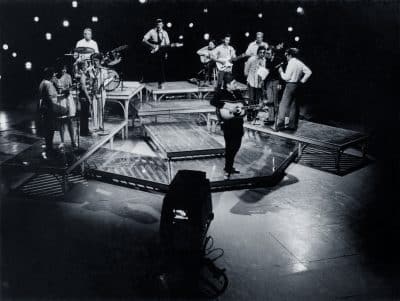
Jim Thompson:
Boy, I hate to just go into something as much of a trajectory as this, but I can’t not do it.
Michael Dooley:
That’s okay.
Jim Thompson:
When you say the Johnny Cash Show, do you mean his limited run on television show, or do you mean his concerts, or the prison? Which would be the most awesome answer you could give. [Michael laughs] What do you mean by the-
Michael Dooley:
Okay.
Jim Thompson:
If you tell me Folsom, I will be happier than I’ve been in a long time. But I assume that’s not what you mean.
Michael Dooley:
No. Actually, I wasn’t stuck in Folsom. It was actually San Quentin, and I was there involuntar- No, the real truth of it is, [Alex chuckles] it was ABC-TV that hired me in New York, sent me down there, basically to do promo work. Because instead of an industrial design portfolio, what I wound up with was my portfolio of professional work as a photographer that I was doing, again, as a way of being able to keep myself in an apartment, rent and food.
Michael Dooley:
Yes. This was 1970. He had a show for a couple of years, down in Nashville, originally broadcast out of the Grand Ole Opry, and that’s where I would photograph. During the week, during rehearsal, I would shoot the guests and such, and then send the film off to ABC and they’d use it in their promos for the upcoming shows, that sort of thing. So, that was that gig.
Jim Thompson:
Oh, that’s fascinating. That’s a very important show in terms of rock and roll because he brought in a lot of people that were not strictly country people like, well, Linda Ronstadt walked a line, but he was important to Bob Dylan’s history in relation to this, too. Were you taking pictures of people like that?
Michael Dooley:
Yeah, there were people- Not Dylan specifically, but there was a variety of people coming through at the time I was- In terms of actors, there was Dennis Hopper, that was pretty impressive.
Alex Grand:
Oh, cool.
Michael Dooley:
And it’s one of those things, too, that- since I was sending the film to ABC, and I was young at the time, I never even thought about getting copies of the photos they used. So, I don’t really have any, [Michael found a couple of his photos after the podcast] and I haven’t thought about in so long. But yeah, there were some people that impressed me. In the long run, it was people like Carl Perkins-
Jim Thompson:
Oh, yeah.
Michael Dooley:
– who was there pretty regularly, that I was really impressed with. I mean, for me, I was a much bigger Carl Perkins fan than I was Johnny Cash. So he was pretty impressive in that sense. Yeah. Various other people.
Jim Thompson:
Alex, there’s a famous story where June Carter gave Linda Ronstadt $2 and said, “Go across the street to the five and dime and buy yourself some panties. Don’t come back without them”. [Alex chuckles]
Michael Dooley:
Oh? There, I guess, is a story that leads up to that.
Jim Thompson:
I just want to know if you had any photos.
Michael Dooley:
[laughs loudly] Well –
Jim Thompson:
We can leave it at that. We’ll move on.
Michael Dooley:
[chuckles] No, unfortunately. Yeah. I love Linda Ronstadt. I saw a lot of rock performers, from the Rolling Stones at Madison Square Garden in the late ’60s, to all sorts of other people. But yeah, Linda Ronstadt is one that I regret not seeing, either in concert or at the Opry.
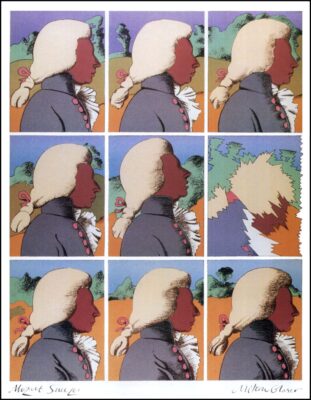
Jim Thompson:
So let’s get to how you came to California, and then I want to launch into your book, because that’s where we’re going to spend a good amount of time. So what made you come to California?
Michael Dooley:
Okay. The Johnny Cash Show, that gig ended. I came back, was living in a basement apartment in Jersey City with my then-wife and my newborn son. And we decided, Jersey City wasn’t the greatest place to be, that whole area. New York wasn’t the greatest place to be in the early ’70s, right?
Alex Grand:
Right. Son of Sam.
Michael Dooley:
You know, we’re talking ’73, when he was born.
Alex Grand:
That was a little later, right?
Michael Dooley:
What’s that? What was later?
Alex Grand:
Yes. Son of Sam was a touch later than that [1976], but the ’70s.
Michael Dooley:
Oh yeah. But it was inspiration, because New York was going down the toilet. There was that whole, Milton Glaser doing the “I heart New York” thing. That sort of thing, which didn’t fix up New York, it just made people feel better about living in the shithole.
Alex Grand:
Yes.
Michael Dooley:
Anyway, we packed up. Pretty young at the time, we came out here. I wasn’t working. Chris, our son, was about nine months old, in the car seat-
Alex Grand:
Oh, wow.
Michael Dooley:
– and so we just came out here and i looked around for work, and managed to land some work.
Michael Dooley:
Before that, in Jersey I was working at a newspaper. I was a designer by that time- again, long-short, graphic designer, doing layouts and such. And, I also started writing back then, because this was early ’70s, and it was at a time when if you wrote articles that get published in- This was a fairly major paper in Woodbridge, New Jersey. And so I started writing album reviews and concerts that I’d go to, and send them off to the record labels. And the next thing I knew I was getting boxes of albums sent to me. This was aside from my other job. And then I also was, like- they didn’t have an illustrator at the time and so I was still doodling, so they said, “Oh, could you illustrate some feature stories that were running?” And I was like, “Okay, yeah, I’ll do that too in addition to the writing job that I wasn’t getting paid for, and my full-time job.”
Michael Dooley:
Anyway, so I was in newspapers. Long-short: coming out here in ’74. 1977, i got hired at the LA Times, from ’77 to ’99. I worked as Creative Director at the LA Times. I ran their Creative Services department.
Alex Grand:
Hm. This was from ’77 to ’99?
Michael Dooley:
Yes.
Alex Grand:
That’s a long time. Okay.
Michael Dooley:
That’s the longest gig I ever had.
Alex Grand:
When you were contributing to Amazing Heroes and such, that was during this time that you were also working there?
Michael Dooley:
Right. In the late ’80s. The nepotism story there is that my brother was, at the time, the editor of Amazing Heroes, and I was talking with him about comics as we do all the time, still. And the subject we were talking about, he was like, “Hey, you want to write that up for Amazing Heroes?” And I was, “Okay, sure.” So that got me back into writing. No free records this time, but just whatever Fantagraphics managed to scrounge up to pay me for. And started out at Amazing Heroes and then realized that, “Well, Comics Journal is really where I belong in that situation.” So I jumped to there. And then after that, it was Print [magazine].
Jim Thompson:
We’re packed up, we’re going to California. Tell us what happens between there and where we want to get eventually, which is you co-editing The Education of a Comics Artist. And that’s a long period of time. You’re at the LA Times. And what else are you doing?
Alex Grand:
And he’s there. He was there ’til 1999. He also contributed to The Comics Journal and Amazing Heroes. And then, now 1999, it ends. And now you’re essentially professorial and you’re co-editing this book. Tell us what leads to the book.
Jim Thompson:
Or other things that you were doing too. Alex, you kind of skipped five years. From 1999 until then, what were you doing, also?
Michael Dooley:
Well, actually, just to jump back from the late ’80s to Print magazine, because that’s pretty much the transition is I got interested in writing for Print magazine in the late ’80s when they put out a special Issue on comics and I was like, “Oh, let me propose a pitch here.” And basically the pitch was for- this is 1990, and it was at the time when High and Low – the Kirk Varnedoe show that was high art and popular culture – that was including comics on display for the first time, notably. And I said, “I want to write about that.” That got me hired and got me made a contributing editor. Then in the course of that, I wrote an article about Emigré magazine, which is a graphic design magazine. And from Emigré magazine, they got interested in me and they wanted me to do an issue of their magazine, which involved interviewing various people from Cranbrook and CalArts as well as Steve Heller.
Advertisement
Michael Dooley:
So, Steve Heller. Just briefly, he’s someone who’s written, co-edited well over 200 books on graphic design.
Alex Grand:
Oh, wow.
Michael Dooley:
I got to meet him in the early ’90s, and got to go to his studio to interview him. We became friends after that. And we still are, I’m very happy to say. He was saying, “Hey, I’m thinking about doing this book.” The one that eventually became The Education of a Comics Artist, “And I’d like a co-editor. I’d like you to be my co-editor.” So it was his idea, he took me on board and I ran with that. Let’s see, that book came out in- Okay. Yeah. I guess we have jumped because now it’s 2005.
Alex Grand:
So when did you guys start working on it? What year was that when you started working on it?
Michael Dooley:
Started working on it 2003-
Alex Grand:
Okay, a couple of years.
Michael Dooley:
– I would say, because it was a long process. We started out with outlining and wishlists of who we wanted to be part of it. The general concept was kind of like a modernization, an update, a book version of the Famous Artists Correspondence School and the Draw Winky matchbook covers. Basically it’s like, “Okay, anybody who’s been thinking about becoming a comics artist, what do you need to know?” Well it’s a lot more complex than anything Norman Rockwell and his gang back in the ’50s were able to tell you. So, wound up that we were able to get original contributions from well over 60 professionals in various aspects of comics, with that idea of, people would pick it up and it would be a sampler kit, really, to be able to flip through. It was by no means meant to be read cover-to-cover. So we’ve got all sorts of aspects of it, as I guess we’ll be discussing momentarily.

Jim Thompson:
Yeah, we want to get right into that and dive in because we want to go through section by section. Let me ask you a question in relation to making it, which is: it does have sections such as the comic business, the comics field, widening the field, education and those- Were those divided between you or did each of you work on all of the categories together?
Michael Dooley:
Not evenly divided at all. We worked together on both and it just happened that- Steve has certain interests, so that was what he concentrated on. and it was pretty much everything else was having me go to town, which I did, a lot of. It’s like, in what I call the “Action Adventure Comics,” that was all me. It was basically, Steve said, as some people would say, is, “I don’t give a shit at all about superheroes. You take the superheroes-”
Alex Grand:
“You do the superheroes. Okay.”
Michael Dooley:
Yeah. Yeah. And I’ve got a lot of feelings about superheroes, which is why the title wound up “Action Adventure Comics”.
Alex Grand:
Right. Because it’s not like it’s you’re totally devoted to superheroes. That would be a misclassification.
Michael Dooley:
Yes. I’ve never actually done a count, but quite a bit of the book is me. And he was definitely guiding me all along. This was the first time I was co-editing a comic- even a book. And even though most of the comic stuff may have turned out to be mine, it was definitely under his expert supervision. So I’m very grateful for that.
Jim Thompson:
We’re going to go through a lot of the sections that will be interesting to our audience. We’ll talk about what you learned, who you picked, why you picked them, that kind of thing. But then with each section, if you were doing it today, if you’re doing an imaginary new edition or, I hope, an actual new edition – because I think it’s definitely called for at this point – who you’d like to see interviewed, what new topics should be explored, what should be, maybe, changed from what was done originally. And in that answer, talk about the topic, whatever we’re discussing within that chapter. The cartoons, the editorial cartoons, the political comics, that kind of stuff that’s in that very first section. And then I’ll turn it over to Alex to talk about the adventure comics and the adventure strips and all of that. So let’s talk-
Alex Grand:
But before we do that, I want to ask Michael one more thing about your Harvey Kurtzman influence. So you mentioned the Mad, Trump, Help, which inspired and he worked with people like Gilliam, Steinem, Crumb, Spiegelman, and fostered a whole generation of counter-cultural comics. But I noticed you left out a long period of his, which was his Little Annie Fanny period that he did for Playboy magazine. Would you consider that basically not real Kurtzman? Would you consider that just kind of a money grab? Is that an embarrassing time of his life, or would you say that there is something to value in that professional phase of his life? I’m just curious about what you have to say about that.
Michael Dooley:
I don’t know to what extent he was embarrassed about it. I know that it helped Kurtzman the bad businessman make a whole shitload of money for the rest of his life. And it’s one of those things where, yeah, there’s stuff in there that’s interesting, but you really have to dig for it. And I guess it was also one of those times where, okay, so, I’d be about in my early teens when he started working there, and I’d say this is one case where he not-exactly came along at the right time because- I found myself, of course, picking up Playboy, for the articles [Alex chuckles] but the thing about Little Annie Fanny was it was so weird. It’s just one of those things that- I can’t even quite understand the arousal factor there. It’s just, she was such this inflatable doll, two-dimensional person, that it was pretty much- that she was just unreal. Basically what was happening around that time was also when I was picking up The Realist. So there was the transition there.
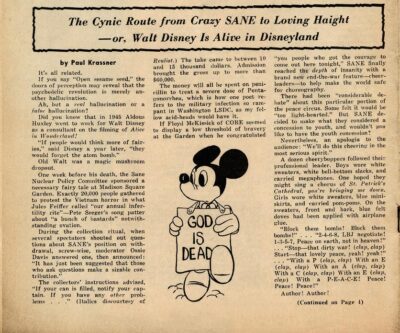
Michael Dooley:
So yeah, he did 20-something years of Annie Fanny with Elder, but for me, the pinnacle of Kurtzman’s career, Kurtzman and Elder, was Goodman Beaver. So after that, it was just pretty much- Again, to get real personal, this was right around the time my mother passed away, and I was pretty much on my own at that point. And so there was a transition there where pretty much Paul Krassner became my mentor. I was living in New York, as was he at the time. And so, The Realist became the Bible that the early Kurtzman stuff once was when I was younger. That’s basically it in a nutshell, as far as not really caring about Kurtzman, other than to talk about the production values, but, you know. Okay.
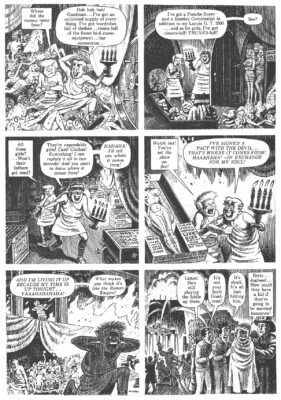
Alex Grand:
There you go. Yeah, that makes sense. It was a diluted Kurtzman. It wasn’t the same as what it was before and he was past his peak, essentially, as far as cultural significance and things like that, okay. That makes sense.
Michael Dooley:
Yeah, yeah, pretty much. But in the sense that so many people have 50 years where they were doing spectacular stuff, considering late ’40s to early ’60s, that’s like 15 years of dynamite. It still puts him up there in the pantheon-
Alex Grand:
Of course. Of course.
Michael Dooley:
– for me, as “God the Father.”
Alex Grand:
[chuckles] That makes sense. It makes sense.
Michael Dooley:
I guess- Or, actually, maybe if I was doing a trinity, maybe Eisner would be God the Father, Kurtzman would be God the naughty son, and Feiffer would be God the Holy Spirit. Not the actual Spirit. [laughter]
Alex Grand:
This is a very Catholic trinity description. I like it. Okay. Well done.
Michael Dooley:
Yeah, we’re there. We’re going there.
Alex Grand:
All right, Jim, go ahead.
Jim Thompson:
Okay, so the first section that covers- It starts with a section on magazine cartoons, then one on editorial cartoons, and then on political comics. In terms of the magazine cartoons in things like The New Yorker, but also a lot of other magazines going back further in time, that’s an area of comics history that really does not get nearly enough discussion in my opinion. And it’s significant, I think, that that’s where you start. What was your thinking in terms of that? And you have three articles in that, three writings on it. How did you come to those versus other ones? There’s so much you could have chosen from. You did start with The New Yorker, signifying that as significant, versus Puck or some other things. What were you thinking in selecting the ones that you picked?
Michael Dooley:
Well, in terms of this being a book that the layperson could easily pick up and appreciate as well as some of the more in-depth stuff, so it’s like an all levels, all ages sort of thing. My thought was that, in terms of people who are going to be looking at the cover, reading the title, that sort of thing, probably, for the most part, what they’re going to be thinking of is the single panel cartoons, in a broad sense. You have the geeks and the rest of it, but there’s- Whatever. Preaching to the choir. So I thought that “magazine cartoons” was a good place that pretty much everybody is familiar with, in all its various aspects. And, of course, The New Yorker being iconic. So, what better person to ask than Bob Mankoff who, at the time, was the cartoon editor. A really funny guy in person too. That’s where it started. As I recall, speaking of the devil, Paul Krassner was also one of the people that I got there to-
Alex Grand:
He wrote a chapter, yeah.
Michael Dooley:
– the cartoons in The Realist. Most famously, your fans would know his Disneyland Memorial Orgy double-page spread that Wally Wood drew on the occasion of Uncle Walt’s passing away.
Jim Thompson:
Oh yeah.
Alex Grand:
I didn’t know he did it for Walt Disney’s death. I didn’t know that.
Michael Dooley:
Yeah, that was pretty much it. The idea was- Okay. Actually, on the cover of that magazine, there was just Mickey Mouse himself, with a sign that said, “God is dead.” And so this is pretty much- Paul was able to extrapolate, “Okay, now that their God is dead, what’s going to happen to them?” And so yeah, orgy time and- So yeah- You know. Woody gets involved.
Jim Thompson:
So if- In terms of the magazine cartoons, you don’t focus necessarily on an individual so much, but I wondered if you were doing it now- I just bought the Fantagraphics Art Young book, which is just brilliant. Have you seen that?
Michael Dooley:
Oh yeah, I have that. Yeah, I picked it up as soon as it came out, yeah.
Jim Thompson:
I just love that book. Are there artists of that earlier period that you’d like to discuss in that magazine cartoon section? And do magazine cartoons still have any power, or do they become just a New Yorker joke about not getting the jokes anymore?
Michael Dooley:
Yeah, good point. Yeah, The New Yorker- Definitely, magazine cartoons, in that format, have definitely had their day, but still in all, there are- In terms of, if you were looking at a kind of book that’s maybe the equivalent and more closely, say, tied in with, what’s been going on now, you’ve got a 50-year mark Mort Gerberg book that came out this past year. A retrospective of his work for The Realist and his other publications, such as The New Yorker and whatnot. So yeah, if it was going to be an equivalent that’s, say, even maybe more close than Art Young, who would say fall more in political, then yeah, it would be a Mort Gerberg just doing great stuff.

Michael Dooley:
In terms of what’s happening now, what with the whole dilution of The New Yorker cartoons, where it’s gotten so- That whole separation, that whole word-image separation where they have- It’s like, “Okay, you write the cartoon. You write the caption,” that sort of thing. So it’s like- They’re pretty much pointing out that there’s no real, solid connection there between the cartoon and the caption, if you can come up with three best every single week, or other week, or whatever it is. So in terms of people doing something different, that great concept that you had there of redoing the book, I really like that. I got to give that more thought.
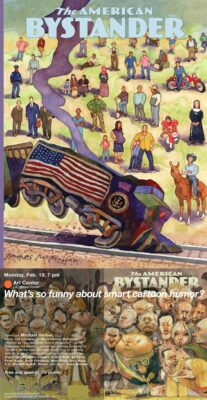
Michael Dooley:
So, there was the Mort Gerberg book, there would be- Let’s see. Yeah, well, of course, Feiffer’s still around, God bless him. Stan Mack, another person who got his start back in The Village Voice with his Real-Life Stories. But in terms of what’s being done now, I would say I would go to Mike Gerber and- Either of you familiar with American Bystander?
Alex Grand:
Yeah. Actually, I think I’m familiar with it because you’ve mentioned it to me before.
Jim Thompson:
Same here.
Alex Grand:
Yes.
Michael Dooley:
Yeah, and one cool thing about it is, if you go to their website, they actually let you download a PDF of one of their old issues. So it’s like, a sample is free, and they have such a wide mix. Basically, you pick it up and it’s going to give off a New Yorker vibe, but it’s much more cartoon-oriented. In that sense, it’s kind of like the love child of The New Yorker and the National Lampoon. And if it was a threesome, probably Spy as well. So they have the old New Yorker folks in there, like Bob Blechman and-
Alex Grand:
Oh, cool.
Michael Dooley:
-George Booth, M. K. Brown, as well as contemporary people. Roz Chast, Seymour Chwast, Howard Cruise – sorry, again, that he passed – Shari Flenniken. Rick Geary, for crying out loud! Peter Kuper, just- I mean, all these people there. There’s Mimi Pond. Ed Sorel doing covers, that sort of thing. It’s just really a spectacular place that’s just- It’s a humor magazine.
Alex Grand:
Advertisement
Right, that’s awesome.
Michael Dooley:
Yeah, it’s heavy on the comics, so I would definitely- I mean, Mike Gerber was one of my guests at my class. He did a great job just talking about American Bystander. And since he was the one who, back in the early days, resurrected The Yale Record, I’d have him talk about that as well, maybe have him back as a guest speaker at another time. Yeah, for magazine cartoons, that would be my lineup. Is that kind-of what you’re looking for?
Jim Thompson:
Yeah.
Alex Grand:
Mm-hmm (affirmative), yeah.
Jim Thompson:
Yeah, that is- That’s fantastic and needs to be done, in my opinion. Talking about the changes in those cartoons, because it was such an historically important part of comics and we know- In my generation, we could name so many different artists and it’s hard for- Regular people could name Arno and those, the Playboy cartoonists, the dark sensibilities of some of that. And a lot of those people have passed in recent years, and I think it would be helpful to know that there are still artists like the ones you just mentioned, that still can do a single panel gag in a magazine that’s not just comic book-related, but for mass audiences.
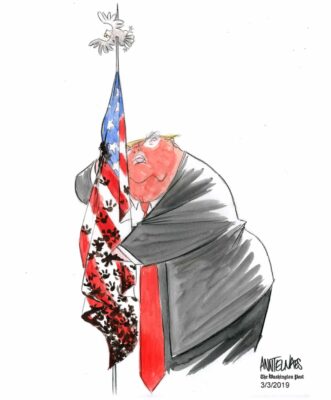
Jim Thompson:
Let’s talk about another mass audience form of comics that is really, really being hit hard these days and is a vanishing breed, which is the editorial cartoons. When you did this, they were still a vibrant factor in terms of political discussion, and they’ve taken a real hit in recent years, haven’t they?
Michael Dooley:
Oh yeah. Well, magazine cartoons too, because newspapers and magazines have taken a hit. Daily newspapers are- They’re already digging the grave for those. Yeah, editorial cartoons, that’s all part of that whole newspaper-defunct sort of thing. Luckily, fortunately, first person that comes to mind is Ann Telnaes. The Washington Post is still running cartoons and hers is, just in my evaluation, just top-notch. And she herself, I’ve met her, she’s just a wonderful person. I’d love to have another excuse to get together with her again. And so, then, editorial cartoons- One person that I’ve had a couple of times at my class was Mr. Fish, Dwayne Booth.

Michael Dooley:
He’s probably the most radical political cartoonist. He does stuff for The Nation and for a lot of the left-wing websites and such. And he’s one of those take-no-prisoners sort of people who, during the Obama administration, hit him hard. And he’s still doing it, savagely, to our present administrator. And he’s just really smart and he’s extremely knowledgeable on the history of editorial cartoons. In fact, I wrote an article about a book that he did that, really, just takes it back to Hogarth, just does the entire history of radical cartoons. It’s just absolutely wonderful. So those two would definitely find their way into that slot.

Jim Thompson:
Have there been other periods of time where political, editorial cartoonists are being fired from their papers for being political? Because that seems to be what’s happened. There are some well-established editorial cartoonists that have been working for 20 years are being let go because they are critical of the current presidency.
Michael Dooley:
Oh yeah, certainly. Yeah, the cartoonist [Rob Rogers] who was writing for- [The Pittsburg Post-Gazette] basically was leaning right. In any event, this gave them- Whatever. There was one step over the line that managed to give them an excuse to fire him. But that’s a big part of history. I mean, there was one situation, speaking of The Nation, just to flip the coin, Victor Navasky, the editor of Nation, who came up with a cartoon that actually was objected to internally. It was a cartoon of basically- Okay, I’ve got to make sure I don’t get it confused with the- There were two very similar cartoons and this one- Do you know the one I’m talking about? Where, basically, it’s the globe, the world is on a bed and lying down.
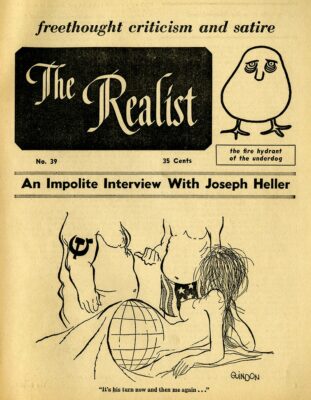
Jim Thompson:
Yeah.
Michael Dooley:
And about to be fornicated upon.
Jim Thompson:
By Russia – the Soviet Union – and the U.S.
Jim Thompson:
Yeah.
Michael Dooley:
And I think that was the one. Because there was another one that The Realist published, but in any event-
Jim Thompson:
I thought that was The Realist.
Michael Dooley:
Yeah. That was The Realist.
Jim Thompson:
I saw that panel in your book, actually.
Michael Dooley:
That was in the book, yeah. That, “It’s his turn now and then me again” [Richard Guindon]. Okay. So I’m going to- It was a David Levine cartoon of Henry Kissinger fucking the world. And it was that whole David Levine cross-hatch style. Just this wonderful rendering that actually was objected to by the women on staff of The Nation because, and this is back when they would call such things “political correctness”. Now they have various other phrases. I think “woke” has been used so much that [Alex laughs] that’s even gone. And so, I’m so unclear as to what the next phrase is, being used. Yeah. I’m not getting the memos anymore. And actually, to his credit, Victor actually wound up running the cartoon of Kissinger screwing the world, over the very strong objections of the staff. That’d be a good one to-
Jim Thompson:
I think that’s an essential one. And, just the notion of political correctness, or “Me Too”, or all the different things that make teaching hard today. And it makes cartoons, and humor, and stand-up comedy, and everything else more difficult because of the new sensitivities. For good and for bad.
Michael Dooley:
Yes. It would be terrific to talk about that. And it would also be a through line. I mean this by far, The Education of a Comics Artist. This isn’t an update, this is a complete revise. This is Volume Two that we are now putting together, and that your listeners are actually getting- Are hearing from the conception stage.
Alex Grand:
Right.
Michael Dooley:
Only appropriate that we’re talking about fornication and-
Jim Thompson:
Right, right. And me and Jim are the two world powers and you’re our guest. [laughter]
Jim Thompson:
It’s your turn, Alex. [more laughter]
Michael Dooley:
Wait, but before that, I have to say, not only am I enjoying it, but I also- When this book comes out, I’m saying “when” now rather than “if.” I haven’t even lined up a publisher, but you’ll help me out with that. Right, guys?
Alex Grand:
Oh, yeah.
Michael Dooley:
I am dedicating it to you two.
Jim Thompson:
Oh, that’s great.
Michael Dooley:
You know the dedication is already there. Yeah, we got Alex and Jim. Right in front.
Jim Thompson:
So I wanted to ask, before we move on to the adventure stuff. Single panel gags, we were talking about that, and editorial cartoons, and political cartoons. Talk about single-panel gag.
Michael Dooley:
Yes.
Jim Thompson:
I think that there is truly a mass need to consume single panel gags, from this visual standpoint of, there is a phrase and an image and then, boom. And there is this need, I think, that humans have, it’s a creative need that I think separates us from four legged creatures and stuff. Is that right?
Michael Dooley:
That’s “memes”, right?
Jim Thompson:
Yeah, we have that need, but I think that in our current social media world, memes have largely- are now replacing that, as far as public mass consumption. People are getting that from memes that take no real artistic skill, although slightly sociopathic phrases are being used, have replaced the public desire to go out and buy something of a higher and more creative etiquette. Do you feel like that’s also contributing to a decline in single panel gags as a higher art form and on a commercial level?
Michael Dooley:
Well, it’s also kind-of continuing along with that discussion we were having about the New Yorker. I mean, of course many enter, but few are chosen with their caption contest. But you know, it’s pretty much basically the same sort of thing. That whole, “My kid could do that,” sort of mentality. And it’s pretty much, “Oh, I can do that.” Just the New Yorker isn’t sharp enough to accept the 700 contributions I gave them. [Jim cackles] So it’s become something so easy to do, so slapdash, that it’s become trivialized. That’s a good point. And I think I’m going to have you contribute to that chapter on poor memes.
Alex Grand:
Yeah. because I’ve analyzed this and I’ve thought about it. Those memes have destructive influence on the arts. And I think it’s just one of the many things where the internet, it kind of went wrong at some point.
Michael Dooley:
Well, I hope that somebody comes up with a meme of me saying, “Fuck memes.”
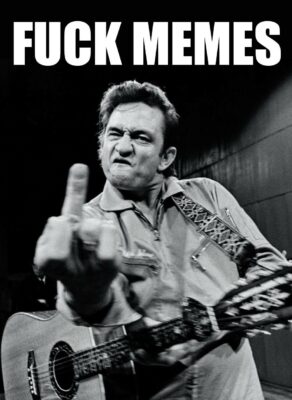
Jim Thompson:
It’ll have Baby Yoda saying it, and that’ll make it all okay though, for me. There you go. So cute.
Michael Dooley:
Yeah.
Jim Thompson:
It’s so cute. Oh yeah. All right. Political comics, because, aside from what you were talking about earlier, there’s not a lot of that. World War 3 [Peter Kuper and Seth Tobocman] hung in there for a long time, but it’s not really something that we- It was one a pretty pronounced, early in comics history, that was sort of a beginning of comics in Great Britain and here. And it doesn’t really exist very much anymore, does it?
Michael Dooley:
Well, coincidentally my contribution from Peter Kuper is called “Launching World War 3.” Where, basically, he talks about how it really has been the longest running underground comic book in the universe. But in terms of the power of political cartoons, I have two words to say to you guys. Charlie Hebdo.
Jim Thompson:
Right? Yeah. Okay.
Michael Dooley:
And that is actually, that was the inspiration for me actually proposing my class, my History of Comics class, originally. Because it’s something I’ve always been thinking about. I mean, I’ve been teaching a History of Graphic Design class for the longest time, and that’s been my passion all my professional life. But comics, I’ve been researching since I was two. And I’ve always been thinking about, “Well, I’ve got to do a history of comics.” And then that horrible- Those murders happen. And I just wrote stories for Print about it, my outrage. And I still felt I had to do something more. And I have been. And starting that class was one of them, which was one of the reasons that I only had one guest speaker in my first class after it started up. And that was Mr. Fish.
Michael Dooley:
He’s one of the few editorial, political cartoonists with any guts, that sort of thing. But yeah, in terms of the power of political cartoons, I mean those people, they knew they were putting their lives on the line and they did it anyway. I mean, that kind of courage is just, it takes my breath away thinking about the guts of those people, to do it. And I’ve got nothing but admiration for them.
Michael Dooley:
Advertisement
And I realized that that sort of stuff, on a global scale, it’s still going on. I mean, there’s so much global censorship that comes along, you can read about in other countries every day. There are people being put to death. So yeah, that definitely is part of that political comics chapter. And it also speaks to the relevance of it in 2020 here.
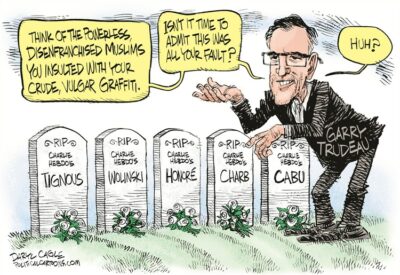
Jim Thompson:
So Michael, before you mentioned Charlie Hebdo, I was going to bring up Doonesbury. And then once you brought that up, now I have to bring up Doonesbury again and Trudeau, but in a different context. So talk about what Trudeau said about Charlie Hebdo, and what your thoughts are on that.
Michael Dooley:
Okay. Just for starters, I’ve never liked Doonesbury. It’s one of those things where he was doing a college comic strip back in college and it never stopped looking like that. And it seems to be a point of pride with him. And so I had that ongoing prejudice coming in, since the first time I saw those college strips. And then, that he would go and he would actually blame the victims, as he did, was just disgusting. It’s just like one of those people- I’m just very sorry to hear that that wasn’t challenged more than it was. I’d love to do a roundtable, if anything, not for this book because it just- What he did was so fucked up in the first place that it just doesn’t warrant that much attention, and I’d just like people to move on from there. So I wouldn’t even want to include anything like that in the book. It’s just very sad. And, as you can see, it still makes me very angry. I’ve got no love for Doonesbury.
Jim Thompson:
And Doonesbury is very important strip for me, but when Trudeau said what he did in terms of the Charlie Hebdo stuff, I thought that was a little on the, I hate to say cowardly side, but I don’t think it was constructive. I thought it was not helpful to some degree. My other question, and then we’re going to turn it over to Alex, during your LA Times experience, did you run into Ted Rall, speaking of politics and comics, at that point, or not?
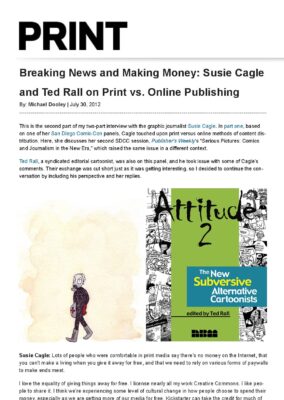
Michael Dooley:
Let’s see. I’ve interviewed Ted Rall about- It was a two-part print feature that I did on Susie Cagle, he had his disagreements with her. She’s doing political cartoons, on-the-spot reportage, along the lines of what Stan Mack was doing with Real-Life Funnies, where she would go to the Occupy Movement camps and draw what she sees there.
Michael Dooley:
In any event, she and Ted had a differing of opinions, so I interviewed the both of them. But in terms of- I gave him his voice there. And I respect Ted for putting out those books that he did a while back on alternative comics, where he really gave a forum to introduce so many of the unknown people. It’s just- If you look up “alternative comics” “Ted Rall”, you’ll see the list of people he had in those volumes. That is all for the better that he did that.
Michael Dooley:
I respect him for that. I know he had an issue with Art Spiegelman having his “old boys club” or his “School of Visual Arts Club”, and wouldn’t let other people in. But that’s something that is just- That’s one of those things where I’m a little more toned down. I think both sides have their point there.
Michael Dooley:
The fact that Art Spiegelman, when he’s editing a publication, he is going to put in things from his perspective. It’s like the “Best American Cartoons of the Year” sort of thing. It’s like if you’re the editor, that’s what you do, and that sort of thing. But Rall also had other points about Spiegelman that definitely held its weight. So it’s good to continue to keep that in mind. So I’m glad you brought it up, but that’s it in a nutshell.
Alex Grand:
So, I’m a big fan adventure comic strips, and I started out as a kid reading adventure comic books, and as far as comic strips that I really like, I really like the Raymond Flash Gordon, I’ve read all of the Milton Caniff’s Terry and Pirates, I’ve read Wash Tubbs, I’m a big Wash Tubbs Captain Easy fan-
Michael Dooley:
Roy Crane, the greatest.
Alex Grand:
I’ve read all of Roy Crane’s run on Wash Tubbs, and Scorchy Smith with the Noel Sickles run, specifically. So let’s talk about the comic strips. So what were comic strips that were important to you as a kid reading? You named a couple earlier, but tell the audience what were comic strips that you thought, “Okay, wow, this is a good story. I’m going to keep reading this.”
Michael Dooley:
In the adventure genre that we’re talking about here or in the superhero sense?
Alex Grand:
I would say probably more of the oldest strips of ’30s and ’40s. Not so much the superhero stuff, just the adventure stuff. Basically, the progenitors stuff to the superhero stuff.
Michael Dooley:
And that goes back to those days for me as a kid in the 1950s, where I would pore over Alex Raymond’s Flash Gordon, and Hal Forster’s Prince Valiant with the captions, that sort of thing, and of course Dick Tracy was definitely part of that whole action-adventure, where I would be checking out the CrimeStoppers Textbook all the time. In the ’50s it still had a bit of an edge. It wasn’t quite as gritty as back in the early days, when his villains were really nice and fucked up.
Alex Grand:
Also Dick Tracy was shooting those villains in the head, killing them too. The ’30s run is incredible.
Michael Dooley:
Yeah, definitely. That was definitely its heyday. But again, those comic strips were primers for me, in terms of leading me back into finding out the good stuff.
Jim Thompson:
We would say that comic strips are an influence on the comic books. Eisner has stated as such, that comic strips that he read, even Bob Kane, who’s a little dubious in his histories, but he said that he’s also-
Michael Dooley:
[laughs] You’re so polite.
Alex Grand:
That comic strips were a big influence on him as far as the early comic books, has that been a little bit of a mini-field of study for you in a sense of going back and looking at the ’30s stuff and then looking at the early comics and contraposing some language or transition between the two media? How do you feel that the one media affected the other?
Michael Dooley:
That’s why in my Trinity I figured that Will deserves the God the Father title in the sense that, I know we’re going to get to Masters of American Comics later, but just to jump in there, he was pretty much the transition figure. The Masters of American Comics, as it was displayed here in Los Angeles, the Hammer Museum had the comic strips and the Museum of Contemporary Art had the comic books, but still Eisner was part of that comic books. It was like, the comic strips ended with Peanuts.
Michael Dooley:
And speaking of Eisner as a progenitor, he paved the way. He also came up with, whatever you want to call it, the “factory system” for producing, taking away that individuality, so that now there’s this whole list of credits for the mainstream comics. But to go back to those comic strips, you take a look at- Dick Tracy was part of that, and they displayed so many of the good ones, like we were talking about the 1930s. This was Chicago, this was the Depression. These were people who were trying to get money by any means- They were hungry.
Alex Grand:
And it was produced for the Chicago Tribune syndicate as well.
Michael Dooley:
Right. Syndicate. [laughs] Yeah, definitely. And in terms of our fandom overlapping here, Milt Caniff was the person that they chose for action-adventure. And for me, I can certainly understand it in terms of the influence he had. It wasn’t as dramatic as the Buz Sawyer and Wash Tubbs, but I wouldn’t have mind seeing- At least, if there was a subdivision of that category, I would definitely have Roy Crane in there, too. You can see so much of what Roy Crane does, now in comic books, there are plenty of people that still draw from his work.
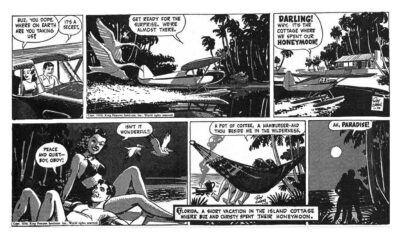
Alex Grand:
I would even go on to say that Roy Crane had an ability to put adventure with comedy together. And I think that’s actually a recipe for- A lot of the Marvel comics now, they throw adventure with comedy, and even the Marvel movies mix adventure and comedy. And I think Roy Crane is really important in the history of combining the two things to create a real effective entertainment.
Michael Dooley:
Very good. Yeah, yeah. And that artwork is to drool over, except you don’t want to go putting liquids on duotone boards.
Alex Grand:
[chuckles] Eisner mentioned his influences, so Herriman with Krazy Kat, Segar’s Popeye, and then, as you mentioned already, Caniff’s Terry and the Pirates. Were those strips that you’ve read, and were they important to you as well?
Michael Dooley:
Yeah. It was in the early 1940s that Herriman stopped doing Krazy Kat, and justifiably so. It was not picked up by anybody else because- Seriously, who could, ever? So again, this was a coming-back thing. But yeah, Popeye, there was the Sagendorf, and of course the Fleischer cartoons and the rest of it, the animated cartoons from Popeye, to Betty Boop, to Superman, they were definitely a strong part of that. Again, it was nice to go back and experience the whole Thimble Theater, especially Popeye and the rest of it.

Alex Grand:
That’s interesting. This is a side question, this is like with Jim and the music, is Feiffer’s work on the Popeye movie and how that movie seemed to combine characters from the strip, but then it had almost like the Max Fleischer-esque, almost, language in a lot of the scenes. Did you feel like Feiffer’s Popeye script, Altman direction, do you think that was an effective Popeye movie? I’m just curious because you know a lot about a lot of the factors involved there.
Michael Dooley:
Oh gosh, this is maybe one tangent that you might have to splice out because I really can’t remember. I saw it once, and I don’t remember being that impressed.
Jim Thompson:
Kind of forgettable, right? Kind of forgettable.
Michael Dooley:
Forgettable.
Alex Grand:
That’s what I mean. All the ingredients you think would be good, but it wasn’t that great.
Michael Dooley:
Yeah. It’s like, “Oh, look at Altman, look at Robin Williams. Look at all the talent.
Jim Thompson:
Boo! Boo! I disagree.
Alex Grand:
Jim likes it.
Michael Dooley:
Alex, you troublemaker, you and him fight.
Jim Thompson:
The juxtaposition of the comic strip coming from, which is what Feiffer is doing in the script, and what Altman is doing in terms of the Fleischer cartoons and so forth-
Alex Grand:
Right. That’s what it is.
Jim Thompson:
– creates a real fission, and that’s interesting. But as somebody studying film, it is a fascinating film, because of that contrast of ideas. Somebody that loves Popeye watching those things play out like a debate about which one is more interesting, the cartoons or the comic strip. Does it fail as a movie? A little bit, yes. But is it an interesting thing to study as a film? So much so. I-
Alex Grand:
Well it is, yeah, especially if you’ve read the strips and then you’re familiar with the cartoons and you see the elements, that both elements of the movie, it’s interesting from that perspective. I think just from a mass audience, it’s tough for most people to grasp that.
Jim Thompson:
And not to curse, but fuck the mass audience. [Michael laughs and applauds] I care about what I like, and I like- The mass audience, it wants to go see Titanic. And I’ll leave it at that.
Alex Grand:
Right. Well, that’s a good point.
Michael Dooley:
Does that bring us back to superheroes, and Martin-
Jim Thompson:
Nicely done, Michael.
Michael Dooley:
You could do a- If you want to stick with the movie theme, I’ve got two words for you. Martin Scorsese. [chuckles]
Alex Grand:
There you go. There you go.
Jim Thompson:
No. [Michael laughs] But let me ask a quick question, Alex, and I’ll go back to you. On the transition in the book from political comics to comic strips. And this carries over, you set it up, Michael, when you said that- I asked about Art Young and you said that was more editorial cartoons than magazine cartoons. Even though he did both. It seems like as the flow of this book goes, there’s always like, well that could have been in the chapter proceeding it or the chapter following it. There’s a lot of natural flow in this.
Jim Thompson:
Advertisement
So in comic strips, Alex is asking you about these specific ones, but the ones that I would think of would be Crockett Johnson’s Barnaby and Walt Kelly’s Pogo and those which are political become very, very- And we mentioned Trudeau obviously, but I know your feelings on that. [Michael chuckles] But there’s a lot of comic strips from editorial cartoonists or that are focused on politics. How do you decide when you’re doing this, which section something might belong in, and what are your thoughts? I assumed that things like Pogo were of great interest to you?
Michael Dooley:
Oh definitely. Yeah. Yeah. That was all part of that 1950s era with Feiffer and the rest of them. And it was done in such an accessible way. Yeah, that’s definitely part of it. If you look at, say, in the comic strip section, the four people who contributed to that, it’s not very political. For me, the interest in comic strips- One interest that’s been revitalizing the field has just got to do with the history. Of course there was- You take what Peter Maresca is doing with Sunday Press. That is so- What a godsend.
Alex Grand:
It is. It recreate the size and the magnificence of the Sunday pages.
Michael Dooley:
Yeah. Yeah. Just the idea- I have a clear memory of my brother and me on our stomachs in the living room of our grandmother’s house. You just open that spread- wow!
Alex Grand:
That’s true.
Michael Dooley:
Plenty of real estate there. I mean, Peter Kuper wound up in political comics and he does comic strips, as did David Rees with his Get Your War On. He wound up in political comics. Some comic strips, that was the decision. It’s like following political comics you have comic strips. We’ve already just had two chapters with politics. Let’s switch to comic strips, and then after that kids and teens comics. So it was that kind of toning-down of that section.
Alex Grand:
Something for everybody. Something for everybody.
Jim Thompson:
One other thing, Michael, on that, which is, we talked about political comics and politics, but all things are politics to some degree. And I think one area that wasn’t done enough in terms of comic strip history, not in the book, but in an actual comic strip history, is “women as politics”, “race as politics”, those things. And what Boondocks did is significant, but we have an opportunity, it seems like, in comic strips today to delve into diversity and different kinds of- We talk about “Me Too” as a negative, like “awareness” and “woke”ness as a negative, but there’s also a great positive in what comic strips can do about sexual politics and otherness in different ways, and not be so white male that it traditionally has been. And I wondered if that’s something, a direction that also should be covered in a new version.
Michael Dooley:
I agree with you, so much to the point of – and I’m going to have to talk with Steve Heller about this – but after hearing that and everything else that we’ve been talking about, it’s “Fuck the dedication. I want The Education Of A Comics Artist Volume Two to be edited by Mike, Alex, and Jim.” Okay?
Alex Grand:
[chuckles] There you go. I like it.
Jim Thompson:
Okay.
Michael Dooley:
All right?
Jim Thompson:
All good.
Michael Dooley:
Yeah. Okay.
Alex Grand:
It shall happen.
Michael Dooley:
And that’s what- Actually, to go back to greasing you guy,s [Alex cackles] one of the reasons that Comic Book Historians were-
Alex Grand:
Is that a three-way reference again? What is it?
Michael Dooley:
Yes indeed. [Michael and Alex chuckle] I knew you’d pick- One of the reasons that I think Comic Book Historians is the world’s greatest podcast is because of the way that you folks put together- The people that you have on there, you put together shows that you can go back and listen to years later and it’s so fresh.
Alex Grand:
That’s actually one of the things we’re going for, yeah. Thank you.
Michael Dooley:
And it’s so fresh, it’s so smart. You’ve got Chiarello, Fingeroth, Chaykin, Trina, the rest of them going back to Bob Beerbohm and Rick Marschall, I mean, this is really what a Podcast for the Ages should be. And I thank you for that.
Alex Grand:
Oh, that’s nice.
Jim Thompson:
Oh, thanks Michael.
Michael Dooley:
Yes.
Alex Grand:
That means a lot to us. Thank you. We care about the effort. And that’s why I think we resonate so much with your book because I think we feel like-
Michael Dooley:
I see that now.
Alex Grand:
– your book does the similar thing in book form, and I think that’s really marvelous.
Michael Dooley:
And that’ll be the kick. When this book comes out, people will be able to go and be part of the inception of Education, Volume Two.
Alex Grand:
There you go.
Michael Dooley:
So, okay.
Alex Grand:
As far as the strips go, this is kind of a more global question, is the staying power of a good comic character. And it’s tough because not everyone can draw a figure and then everyone will continue to want to read about that character. So Bill Griffith wrote about, in one of your chapters, Zippy the Pinhead, and the staying power of a good comic character- It’s hard to get a good grasp on that, because all the characters are so diverse and different from each other. Peanuts probably looks a little bit like Cathy, but then those look different from, let’s say, a Flash Gordon character or some well-illustrated Prince Valiant. Is there a theme? Can it be put into a sentence, the staying power of a good comic character? How does that get created?
Michael Dooley:
That would be great to put in the chapter of, actually, the “Creation of Comics”- .
Alex Grand:
Right.
Michael Dooley:
– which is also a chapter which you’re going to be in charge of putting together. For me, it’s always so much about form and content. I mean, yeah, certainly there are comics, that if they are generic enough, you can pass them on from one person to another. And you brought up Pogo. Walt Kelly did it, and they tried to see if they could manage without him, but no, it couldn’t. So there’s a- Pogo is something that is all of Walt Kelly. The way Krazy Kat is all of Herriman. And there’s no way of passing that along.
Alex Grand:
Yeah.
Michael Dooley:
I mean, yeah, with your example, who’s going to be the inheritor of Zippy when Bill passes it along?
Alex Grand:
That’s interesting. It sounds like it matters about the creator, and then their creation, is like a lens to the audience. And if that creator is switched out, that lens, the quality of that lens, and what people are getting out of it, is changing. And so it sounds like the creator link to that character is really important. That’s kind of what you’re implying there.
Michael Dooley:
Oh yeah, yeah. For that sort of thing. And as I was also saying, it’s about the subtleties and complexities. If you pretty much have a character that can be totally summed up in a sentence or so then yeah, you can pass it along fine.
Alex Grand:
There you go.
Michael Dooley:
And there’s no trouble. But if it’s got those layers and that visual aesthetic to go with it – which is always important, always a component that needs to be considered – then the character lives and dies with the creator.
Alex Grand:
Yeah.
Michael Dooley:
So it’s a case-by-case basis.
Jim Thompson:
I’m curious about that. If it is about the character itself, or luck in who comes on board afterwards. But I think of things like Alex Raymond books where they still work today. I mean, the artist that came on Prince Valiant after, right up now to [Tom] Yeats, is still a joy to look at.
Alex Grand:
Those still work.
Jim Thompson:
I think of Buck Rogers and I think of Tarzan, and how many great artists have done Tarzan. Whereas, you think of some comics, like the ones we’re talking about, or as seemingly simple as Charles Schulz. Peanuts could not be done by anybody else.
Alex Grand:
That’s right.
Jim Thompson:
Exactly.
Alex Grand:
It seems like adventure is easier to transition between different people, but-
Michael Dooley:
Yep.
Alex Grand:
That’s interesting. But the comedic cartoon, that’s harder.
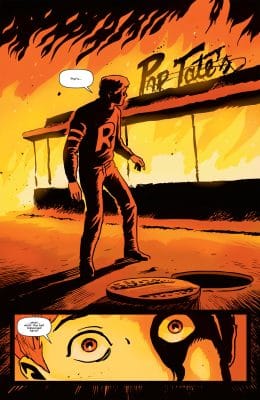
Michael Dooley:
Advertisement
In terms of longevity, by being simplistic, that has lasted since the late 1940s, I have one word for you, Archie.
Alex Grand:
Yeah, there you go. That’s continuing for sure.
Michael Dooley:
Yeah. And they’re fucking around with it.
Jim Thompson:
Hah!
Michael Dooley:
Now, Archie is more like a Goodman Beaver parody of Archie.
Alex Grand:
Yeah. That’s funny.
Jim Thompson:
Yeah, that’s actually true.
Alex Grand:
So to transition, and actually the staying power of the character connected to the creator, let’s use that to transition to comics. Steve Gerber was kind of like that with Howard the Duck, because Howard is not the same without Steve Gerber. And that leads me to comic books now. So as far as your comic book section, there’s interesting creators that have chapters in your book. So Jim Steranko obviously, who I’m a big fan of and we’ve had on the show before, there are two things he kind-of writes, and I think he kind-of looks at it that way, but it also just comes down to the way the two parts that comes into a comic is, first, the writing of the comic.
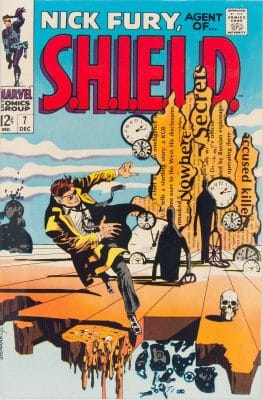
Alex Grand:
He mentions the pulp precursors to comics in there, like how the Shadow was a precursor to the Batman. And how he read a lot of pulps and pulps were a huge influence on him. And then from the visual of the comic, his big influence was the cinema, putting cinema into his comics and putting those camera angles and the choreography panel-by-panel. So it seems like pulps and cinema writing and the art of the comic, it seems like that’s Jim Steranko’s kind of thing. When you read his Captain America and Nick Fury, and then his later graphic novels, what was your impression of Jim Steranko’s contribution to comic books and the comic medium, graphic novels? What was your impression of Jim Steranko?
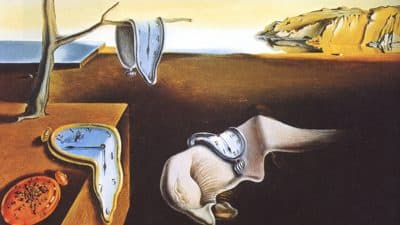
Michael Dooley:
Well, certainly his contribution started out with his volumes one and two of his history, where he got into, as you were saying, all those roots with the Shadow, the Spider and the rest of it, which is truly the origin story of superheroes from that sensibility, from the literary sensibility. And yeah, from the visual sensibility, when I first saw it, it was impressive. But then it was one of those things where I was going, “Oh yeah, I see what he’s doing.” This was post-Batman TV show. It was okay, comics-Pop Art and that kind of stuff. You look at his stuff and you go, “Okay, there’s the de Chirico and there’s the Dali.” It would’ve been nice if it was transformed more, that if he had made it his own. And while it isn’t just straight appropriation, it isn’t a cut-and-paste job.
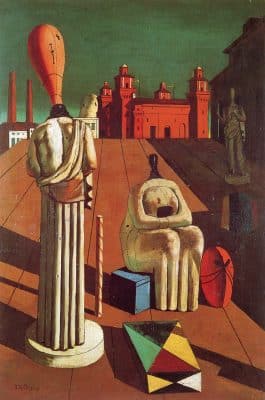
Alex Grand:
No, yeah.
Michael Dooley:
With the clocks and the columns, the rest of it, it’s so close that, okay, if this is meant to evoke otherworldly for anybody with a basic knowledge of Surrealism, no, you’re just sending the mind off in another direction. That said, he is a master of composition, of lighting, the wonderful stuff that he’s done. You think of Guido Crepax, the kind of chiaroscuro, Alex Toth, and the rest of it. It’s brilliant. But when you asked me specifically about the Captain America stuff that people go and point to right away, it’s, yeah, that kind of came and went. That, for me, didn’t have the sustaining power that the rest of his small body of work did.
Alex Grand:
Right, right. Like Chandler. And then he did that Outland, what, for Heavy Metal magazine [yes]?
Michael Dooley:
Outland. He did ComicScene, that evolved into MediaScene.
Alex Grand:
Right. I have a lot of those. Yeah.
Michael Dooley:
He actually is- My interview with him lasted twice as long as what appeared- I mean, half of it is on the cutting room floor. So, he’s extremely knowledgeable and really fascinating about what he had to say. But again, it was a space limitation. He had, I think, pretty much the longest piece in the book. And it could have been twice as long. Yeah.
Jim Thompson:
I think Michael, that he kind of – and this may be in keeping with what you’re saying – I think he sort of Lichtenstein-ed Surrealism. He just takes the base thing from Dali and puts it there in comics rather than understanding philosophically what it is.
Michael Dooley:
Sure, exactly.
Jim Thompson:
The way that other people do.
Michael Dooley:
Well-put.
Jim Thompson:
When someone like Alan Moore wants to do what anarchy is, he understands it intellectually and you can see it in every page that he’s capturing the politics of an anarchist. When Steranko is doing the notion of a Surrealist, he’s just copying. And it’s not in a swipe way, but he’s just emulating what he sees on the page without getting it philosophically, is what I would say.
Alex Grand:
But what I would say is one of the main visual standouts of his Nick Fury run is, it’s- James Bond movies were a huge part of the Nick Fury, and I think if you were to look at the stuff coming out of Marvel in the late ’sixties it’s fun Silver Age stuff. And, but I would say that the stuff he did specifically stands out, though, in that he still punched through a lot of what was expected of a Marvel artist by Stan. I think he was still able to punch through that and still make a statement when everyone else was like, “Okay, I’ll just draw it like Kirby.” I think that Steranko still punched through in a way where under the strict vision of what Marvel was supposed to look like, he was still able to go in and make a statement. Especially with some of that horror stuff, and the romance comic he did. He still was able to do things that other people couldn’t at that time in the late ’sixties when certain things were expected of artists and writers.
Michael Dooley:
Yes, yes.
Jim Thompson:
Absolutely. My only criticism was his clocks and what he’s doing-
Michael Dooley:
Right.
Jim Thompson:
And being credited as a Surrealist or anything like that. I think that’s more, just an emulator.
Alex Grand:
Right, right.
Jim Thompson:
But in terms of Kirby and that stuff, you compare what he was doing quickly to what Barry Smith was doing and it’s like, he’s much better at taking Kirby. Barry Smith learns how to steal from other artists instead, and not Kirby, and that’s how he becomes famous.
Alex Grand:
But of course that’s pre-Conan Barry Smith, right? I mean his Conan was so-
Jim Thompson:
No, I’m talk– He steals from Conan, I mean on Conan completely, but he’s stealing from other master artists. Not Dali obviously.
Alex Grand:
Oh, I see what you’re saying. Okay.
Jim Thompson:
But he – His style is not an original style. It’s an incorporated style from fine arts.
Alex Grand:
Right, right. The illustrative style that it evolves to is more of a fine arts kind of side. I see what you’re saying. Okay. All right. That’s good.
Jim Thompson:
Which is cool.
Alex Grand:
Yeah. Which is still cool. Yeah. For a Marvel comic, of course. Great discussion guys, by the way, I mean that was stimulating. I don’t know really. You feel that? Do you feel that? Do I need a cigarette? Do we need cigarettes?
Jim Thompson:
I could use some more grease. [laughter]
Alex Grand:
We need more grease. Yeah, let’s keep it coming. Let’s get more grease. Sure.
Michael Dooley:
Okay. I think this conversation is certainly animated, but it’s also getting X-rated, just to drop a Crumb reference, or a Bakshi reference, actually. And if you want to wrap that up with a personal recommendation that I have for, what I’d probably, I guess, if push comes to shove and people were asking me, “What’s your favorite comics book of the past year?” I’d have to say it’s a biography of Andy Warhol. It’s a 560-page biography of Andy Warhol done in a multiplicity of cartoon styles.
Alex Grand:
Oh, cool.
Michael Dooley:
And it is just the most incredible work. Have either of you heard about it?
Alex Grand:
No, I haven’t.
Jim Thompson:
No.
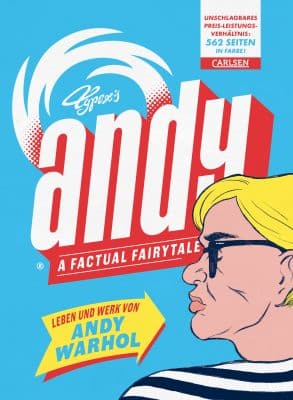
Michael Dooley:
Oh, okay. It’s originally published in Germany and it’s just, in terms of picking up styles, it is so hysterical. It’s like every single one of those nearly 600 pages is just a masterwork in creativity and it’s just- You want to talk about people being able to emulate styles with a complete understanding of what they can do and what they should do, definitely look up Andy: A Factual FairyTale, which is, basically, the life and times of Andy Warhol.
Alex Grand:
Oh, okay.
Michael Dooley:
Because it does get into fantasy. And it’s put out by “Typex.” That’s one of my recommendations. Just to wrap up the Pop Art-
Alex Grand:
The Pop Art section. Yeah. Just two more questions before we move on to the graphic novel section Jim’s going to do. Bill Sienkiewicz, I feel like he impresses me as well, as his own artist, just as Steranko impresses me as his own artist. It’s interesting ’cause it seems like he has that early phase where he was trained with Neil Adams and there was this talk of – especially during the early Moon Knights – of him being a bit of a Neil Adams clone, but then he evolves, in a sense, into his own expressive art form and you see a lot of various influences in it, like Gustav Klimt and other people. What’s your impression of Bill Sienkiewicz’s contribution to comics and his stance of being a true comics- and fine artist? He kind of combines the two things. What’s your impression?
Advertisement
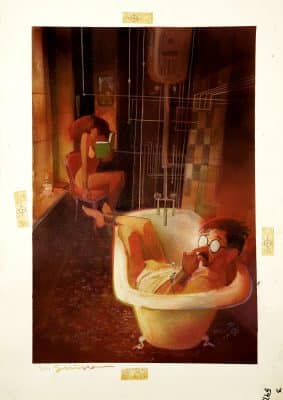
Michael Dooley:
My impression is extreme respect. I think it’s like- as a kid, I admired Harvey Kurtzman just so much, and as someone who reached adulthood and discovered Bill Sienkiewicz, his work in general and Stray Toasters in particular, it’s like, he is on the top of that list in terms of action-adventure heroism. He is a hero to me in terms of how he’s expanded. He’s taken the stuff that have roots in Barron Storey-
Alex Grand:
Right.
Michael Dooley:
-who I also interviewed. And he combines it with what Dave McKean was doing, also.
Alex Grand:
Right.
Michael Dooley:
Another person who was working both sides of the divide.
Alex Grand:
Right. The Sandman covers, and that’s fine art and comics art together. Yeah.
Michael Dooley:
Right. Yeah. Not so much working different sides, but basically knocking down the walls.
Alex Grand:
Yeah, there you go.
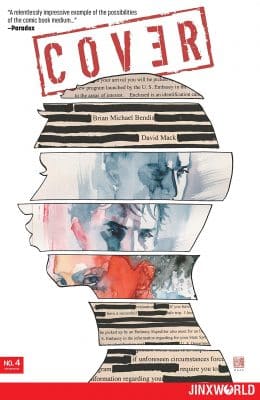
Michael Dooley:
Yeah. And I’m so happy that he came to my class to talk, and I’m also happy that in a couple of months, he and I are actually going to be sharing a panel at the San Diego Comic Fest. Excited about that. And one last thing, too. Also in that chapter is David Mack. And another recommendation: if you haven’t seen Cover – the book that was written in a six-issue series and has just recently last year been put into a paperback – written by Brian Michael Bendis and illustrated by David Mack, who really gets back to his Kabuki roots, and does something- to me, and in so many ways, it’s even more spectacular than Kabuki. Have you seen Cover, either of you?
Alex Grand:
I have.
Jim Thompson:
Yes. I have a slight allergy to Bendis, all things Bendis.
Michael Dooley:
Oh, okay.
Alex Grand:
[laughs] I liked his Avengers, and I loved his Daredevil, but I’m no-
Jim Thompson:
I loved his Daredevil. The reason I don’t like him is because of his Avengers, but that’s another conversation.
Alex Grand:
There you go.
Michael Dooley:
Okay.
Jim Thompson:
But what I really want to have, because I hate what he did with the Avengers so much, and I’m not reading his Superman.
Alex Grand:
There you go. The protest continues.
Jim Thompson:
I haven’t read an issue, but I like it a lot more than I do the John Byrne Superman. I can say that.
Alex Grand:
Okay, well, there you go. See, there’s a silver lining, Jim. It’s a silver lining.
Michael Dooley:
Does it matter that that Cover is not superheroes?
Jim Thompson:
Yes. And I like some of- I read Power. I don’t hate all things Bendis. I don’t like Bendis working in mainstream comics all that much. I think he’s lazy about that. This I will try.
Michael Dooley:
Oh good. I’d love to hear what you have to say about it.
Alex Grand:
I think I’m good. So Jim, why don’t you go with the alternative comics and graphic novels now?
Jim Thompson:
So, alternative comics. What is the definition of it?
Michael Dooley:
I would think that alternative comics – the definition in most people’s minds, if they even think of anything these days – is probably Love and Rockets. And so when we do this book, I wouldn’t use the word “alternative”, I think it has pretty much had its day. It would be something- “Independent comics”-
Alex Grand:
There you go.
Michael Dooley:
– pops up to me. So that would be how that would be updated. And just really thinking in terms of the independent press, basically.
Alex Grand:
Right.
Jim Thompson:
That’s interesting because Chaykin has very clear definitions of those two things and does not count them as the same thing at all. Are you coming from that kind of position on that?
Michael Dooley:
Oh, he has a difference between alternative and independent?
Jim Thompson:
Yeah.
Michael Dooley:
Okay. No, we’re not disagreeing at all in the sense that- basically what I’m saying is, alternative, as a word that means anything significant is pretty much dead and buried. So just let’s get rid of it. Let’s not dance on the head of that pin. Call it “independent” at this point and move on from there.
Alex Grand:
I think “alternative” implies that it’s not mainstream or it’s not for most people, and maybe by saying “independent”, maybe that’s better in a sense, that it’s just coming from a smaller publisher.
Michael Dooley:
Yeah.
Alex Grand:
And it’s open for anyone to read it, basically. Something like that.
Michael Dooley:
There you go. Yeah.
Jim Thompson:
Yeah. Because talking about Love and Rockets, or Cerebus, or those alternative comics that had their roots in underground comics, but were not underground comics, that was one direction. But then there was also First Publishing and Eclipse and things, where they were doing things that were independent and that they weren’t the main, too. I think they’re both words that still have some merit. I get what you’re saying about alternative comics, though. And talking about alternative comics, in your book, you’re talking about people like Gary Panter and things, and not whether it’s Love and Rockets, or Cerebus, or things that came out in the ’80s as alternate comics, that kind of changed the direction to some degree in terms of how they were marketed, the retail, the sales of them and all of those things that are complicated. The first question I would have is, historically speaking, what do you think the impact of Karen Berger as an editor, and Vertigo Comics in general, had on comic book history?
Michael Dooley:
Yeah, great question. Certainly a great heritage because the amount of people that she opened things up to, the amount of focus, her coming from the literary rather than the comics geek world was really a boon. So much of it up until that point was people who were, “Once upon a time I was a snot-nosed comics geek, putting out fanzines, and now I’m the editor of a major metropolitan comics company.”
Michael Dooley:
So her independence, and what she did there, was broaden the horizons. And really, pretty much, you could say that she was one of the people who made the term “alternative comics” irrelevant. And not to put it in the past tense, because she’s still doing good stuff with Berger Books. Luckily, she’s continuing there. It’s pretty much giving that sensibility, that, like, “Fuck the formula. Let’s do this.”
Alex Grand:
Right.
Michael Dooley:
“Then let’s try that.” And yeah, it’s going to continue. What she’s done, the legacy of Vertigo is going to continue, still for quite some time.
Alex Grand:
Yes.
Michael Dooley:
Yeah, definitely.
Jim Thompson:
Even though it’s gone, in my mind, if Vertigo hadn’t come along and the writers that were brought in to work there, going for Moore to Morrison, and so forth, I think comics would have lost me during that period.
Michael Dooley:
Okay.
Jim Thompson:
Alex would be here because he’s younger and was reading the Marvel books and things, and joyfully experiencing Tom DeFalco, and so forth.
Alex Grand:
[laughs] Which I was.
Advertisement
Michael Dooley:
I was reading the Lascaux cave painting cartoons. [laughter]
Alex Grand:
There you go.
Jim Thompson:
But for me, in law school, I don’t know if I would have made it, if not for Vertigo, and then of course, obviously the year of ’86, and all of the things that came with that, Watchman and so forth. But that made a difference for people who mainly traveled in mainstream comics, but were caught by the intellectualism of what Berger brought to that, I think. So, when I think of alternative comics, I’d just add a pitch for that, even though it’s mainstream, DC as the publisher, it was certainly alternative in its definition.
Michael Dooley:
Right. And its reach was such an important part of the process. Kudos to DC for doing that.
Alex Grand:
And that’s Levitz hiring Karen as his assistant, and then he saw a lot of talent and wanted her to have her own brand at DC. So I think Levitz helped facilitate that line of comics with Karen Berger, being obviously the creative engineer of the whole thing.
Jim Thompson:
Yes. So what would you say, in terms of this section, besides changing the title, what would you bring aboard, currently? And one question I would have is where does [Robert] Kirkman fall into this, in terms of, no one’s been more successful in the history of comics in terms of money, probably, than he has with Walking Dead and so forth? Are those alternative comics, or did he just create his own mainstream comic, and that’s where it should be discussed, in the previous chapter on adventure and so forth? And maybe, does alternative comics or independent comics now mean pitching toward the movie industry and TV industry?
Alex Grand:
In a way, yes.
Michael Dooley:
Yeah. That’s become an essential – But there’s no way of separating that, again. For me, I would think in terms of how would you approach a chapter called “independent comics”? I think one thing I’d like to do that isn’t done that much in the first volume of the book is to go to the editors. Go to D&Q, go to Eric at Fantagraphics, talk to, even Scott at IDW, and get their input, rather than keep it narrow-focused to the point of talking about say, Walking Dead in specific. Do it in wider brush strokes.
Michael Dooley:
I think that kind of expanse would be more useful to the reader, in the sense of hearing it from the publisher and the editor would really be covering a lot of important points that you wouldn’t get as immediately with just breaking it up into individual people. You know what I mean? Does that sound right?
Jim Thompson:
Yeah.
Alex Grand:
Yeah.
Jim Thompson:
Yeah. No, I think that’s probably right. Let’s talk about the graphic novels section for a minute, because when I read your book on that, that’s where it seemed to me that, that was one of the most personal areas for you in talking, because your field of graphic design really came into prominence with the people that you selected, with the Chip Kidds, obviously, and the Chris Wares, with Kim Deitch, and Rick Geary. The focus was so much with all of those people, the visual design of the project that they’re working on. I’d like you to talk about that for a minute or two.
Michael Dooley:
In addition to people like the ones you just mentioned, Spiegelman, and also Satrapi. I also wanted to include at least one person who you wouldn’t first think of in terms of graphic novels, which is Ho Che Anderson, who was doing these interesting bits well, he wound up with the King biography-
Alex Grand:
Right.
Michael Dooley:
And he was doing so much else, but it was one of those- People didn’t really know about him. So one of the things that I wanted to do in the book was, “Yeah, let’s bring in Peter Blegvad, who did Leviathan,” and people are- Readers might be going, “What? Well, everything else has been good, so let’s see what they have to say.”
Michael Dooley:
So yeah, definitely you pinned it on me, in terms of what I was trying to do, coming at graphic novels from a graphic design- I mean, the fact that I’m even teaching a history of graphic novels, for me, it’s a subdivision of the class I’m also teaching at my other school, History of Design. Because graphic novels, comics, are for me, a subdivision. That sort of thing.
Michael Dooley:
And it’s something that doesn’t go anywhere near significantly recognized as much. And this is something that- Actually, when I was listening to Howard Chaykin talk, just yesterday, at the Long Beach Expo, he was saying, what’s fucked up about people who are looking at comics, reading comics, critiquing comics, is they don’t know that it’s form and content. He gets shit for Black Kiss, he gets shit for The Divided States of Hysteria.
Alex Grand:
Right.
Michael Dooley:
Because people are reading what it says, and not taking the form into consideration. Basically, it’s without context. And without context, they’re beating him up, and they’re calling him a right-winger for no good reason at all. And so much of the study of comics and graphic novels leaps over into the academic world. So many of the courses in – I know we’re going to be getting around to talking about education as well – but so many of the courses in history of comics and graphic novels are coming from that viewpoint.
Michael Dooley:
They’re coming out of the academic sphere where people are, “Oh, we’ve got to start a comics history class. Let’s get somebody from the English department. Let’s get someone who knows their literature.” And so, for me to talk about graphic novels without including both halves of that phrase, it was what Chaykin was saying. It’s content without context. Yes, it was personal for me. And to take that even further, it’s like, in terms of experimentation- And maybe I’m anticipating your next question, which would be: who to think about when it comes to including graphic novels next time around? Does that sound like a, something that-
Alex Grand:
Yes. That would definitely be part of it.
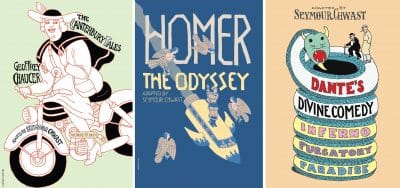
Michael Dooley:
Okay. I would say that I would include Seymour Chwast, who, when he was in his eighties, decided to become a graphic novelist. Are you familiar with Seymour?
Alex Grand:
No.
Michael Dooley:
Okay, the graphic design history there is that he and Milton Glaser started Pushpin Studios in the late ’50s, and basically, they were coming out of a comics sensibility. In fact, Milton Glaser, who you’re familiar with, most known for the Bob Dylan poster, the profile, and the I-Heart-New-York symbol, that whole graphic design that was coming- He talks about how he was influenced, and he was saying, just about all those graphic designers from his era, from his generation, are coming out of reading Prince Valiant and the Sunday funnies.
Michael Dooley:
And so, Seymour Chwast has always had a very cartoony sensibility about him. And he was in his eighties, I believe, when he decided to start doing graphic novelizations of classics like Canterbury Tales, Dante’s Divine Comedy. And he was doing a magnificent job. He did three of those and he’s still at work on it. He just came out with another book that was released, just like, a month ago, This Is Elvis, a biography of Elvis Presley that he worked on with Steven Brower.
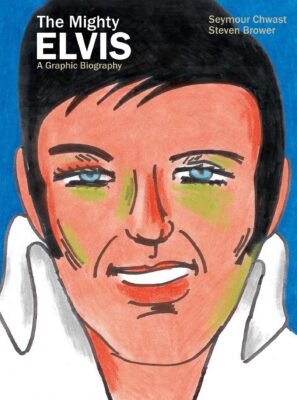
Michael Dooley:
This is one of those things where, for Steve Heller and me, coming from that graphic design sensibility, so much of that reflected- There was that thread throughout- not just graphic novels but through the whole book. That whole realization that there’s more to comics than what the typical comics readers go to. For me, it’s, yeah, I’m delighted to read The Best of The Year lists in comics, but so much of what they include are things that they’re not aware of, that they should be. So this was kind of a secret agenda, unspoken.
Alex Grand:
Right.
Michael Dooley:
We never really talked about it, what Steve and I was doing. So that’s all I have to say about graphic novels.
Alex Grand:
There you go.
Michael Dooley:
What do you think? Okay. What do you think?
Alex Grand:
Yeah, we’ll have to have a further conversation on that subject. Because I would like to talk to you about- because of graphic design, I’d like for you to talk about the debate about whether you have to be a good artist, and whether you have to be- in order to make a good graphic novel, how important the design is or isn’t to that. But I think we need to move on. But keep that in mind for a section in the book, because I would like to have that covered.
Michael Dooley:
[laughs] Okay. That’s delightful. All right, we will do that. And ’em him Groucho sent you. Yeah, okay.
Alex Grand:
[laughs] All right. So, Michael, let’s talk about the comics profession, the Business of Comics, the Creation of Comics. So explain what you wanted to accomplish in these two sections of your book. And I think it’s great, because I think a lot of books that talk about comics, they almost focus on the pictures, or sometimes a narrative, but I love that you really put some of the bones and meat of actually creating in the Business of the Comics. What were you wanting to accomplish with these two sections?
Michael Dooley:
Well, it’s actually, all of these are subsections underneath a larger section, and it’s-
Alex Grand:
Right.
Michael Dooley:
A section – what is it, four? – was The Comics Profession. And so this is kind of getting to that left side of the brain sort of thing. It’s, “Okay, here are some practical tips,” kind of thing. It’s fun to talk about the creativity, but let’s get down to some brass tacks, in the sense that- And starting again from the very beginning, with Heidi MacDonald talking about Comic Cons, which again, anyone picking up the book who’s familiar with comics, she’s not saying anything new to them. But still, it’s an introduction. It’s kind of basics, and a primer, and then it just basically builds on that, going to: popularizing the comics, which- business and creation, there’s overlap there too, like you were talking about, the other overlap, between comic strips and politics.
Alex Grand:
Right.
Michael Dooley:
That whole, to what extent is coming up with a memorable character, how much of that belongs in creation, and how much is business? And we can certainly finesse that, and refine it, and figure out how to present it in both. In terms of the update, the Business of Comics now would have to include finding out who’ve been the most successful comics creators, who got their start on Kickstarter, right?
Alex Grand:
Right, there you go. That’s a whole new thing that wasn’t there, in such full force in the early 2000s.
Michael Dooley:
Yeah, to find- I mean, even Michael Gerber’s American Bystander, that got its Kickstarter start. And I love it so much that when he said, “Now that we’ve got it started, we’re going to Patreon.” I never had a Patreon membership, and I just signed up right then.
Alex Grand:
Good. That’s your contribution.
Michael Dooley:
Yes, “I want this to come to me forever.”
Alex Grand:
Yeah, right, right. The Internet definitely changed that.
Michael Dooley:
Yeah.
Alex Grand:
There are some chapters I really enjoyed, because you can’t really get some of these people anymore. So Joe Kubert, he talked about the school, the dedication, the commitment, and the practice it takes, the hours of physical practice and work it takes, to be good at drawing comics, and the construction of comics. What I like about that is, it’s not like you can get Joe Kubert to write an update on that, but you were able to get a piece of this guy in your book. And I think that was really impressive, and I think a lot of readers would be surprised, that it takes a lot of actual hard practice to be good at drawing comics. I felt like that chapter discussed that really well.
Michael Dooley:
Yeah, and he was wonderful to talk with. He was just very generous with his information. And yeah, I miss him. That was a good interview. I really enjoyed doing that.
Alex Grand:
Oh yeah. Then I really liked Craig Yoe’s chapter. He has a great, it’s almost like a rock and roll love letter [Michael chuckles], to the great cartoonists, from Töpffer to Wally Wood. And then, there’s also some other cool chapters. You got Trina Robbins and her summary of women in comics, which, I think is really important. One, to show the women in comics discussion, to make it a more complete book, which you did, but also that she’s written so many books on it that it’s nice to get that quick summary, to get people interested, and getting other Trina Robbins works, and really expanding that discussion.
Michael Dooley:
And the way she talks about it, she’s got books out talking about the actual women creators of comics, but here, she’s talking about Archie Comics. She’s talking about-
Advertisement
Alex Grand:
Yeah!
Michael Dooley:
-why Patsy Walker is important.
Alex Grand:
Exactly.
Michael Dooley:
And going to sock hops, and even touching on Simon and Kirby’s Young Romance.
Alex Grand:
Yeah.
Michael Dooley:
And getting it from her perspective, she is so wonderful. She’s smart in so many ways.
Alex Grand:
Yeah, yeah.
Michael Dooley:
But I don’t have to tell you that! You had that great interview with her, so-
Alex Grand:
Right, right.
Michael Dooley:
You know.
Alex Grand:
Oh yeah.
Michael Dooley:
Yeah.
Alex Grand:
She’s a very strong personality.
Michael Dooley:
Love her.
Alex Grand:
She, in the Jedi world, would be on that Yoda level of comic history, so to speak.
Michael Dooley:
Ah, there you go.
Alex Grand:
So now, as-
Michael Dooley:
Yeah, just don’t put her in a fucking meme! [laughs]
Alex Grand:
There you go. Baby Yoda Guacamole, anybody? [Michael laughs] So, as far as Teal Triggs, there was a great discussion of girl comics, Bill Woggon’s Katy Keene fashions, et cetera. I’m just impressed that you were able to- not everyone thinks of that, those aspects of comic books, but this – in the creation of comics and in that whole profession of comics – to throw that stuff in there, I thought that was really smart. This really needs to be some, there could be a whole class on this book you co-edited and created.
Michael Dooley:
Oh yeah. I imagine I’m doing sections of a couple of chapters in my class, but-
Alex Grand:
Yeah, exactly.
Michael Dooley:
Yeah, that would be- So there’s actually a whole university to be set up based on this book. Right? [laughs]
Alex Grand:
And you could actually just make a couple subsections into their own classes. I mean, it’s vast. It’s probably not meant to read through in one go, but I did. And I felt transformed after it.
Michael Dooley:
[laughs] Really?
Alex Grand:
And you’re part of that, so I appreciate it.
Michael Dooley:
I was mentioning in jest about turning the book into a university- I mean, the whole teaching comics idea, one of the things I hope to talk about with Jim is the fact that you now can get Master’s Degrees.
Alex Grand:
Oh yeah.
Jim Thompson:
I agree about the teaching on that. And also, I would add that, in other courses, people are using comic materials, things like March, more and more. It’s a fascinating period for that, with a lot more acceptance, but also a lot more resistance along the lines that we talked about previously in terms of what is “woke” or what is acceptable or what is offensive to different students.And also politically, where it fits in with the mind-meld that is current university politics. It’s hard. Let’s talk about education in that context, but also, what about you as a teacher, and we’re going to kind-of phase out of the book at this point into what your own experiences are, where you’re teaching, what you’re doing and what your experiences are with students at this point.
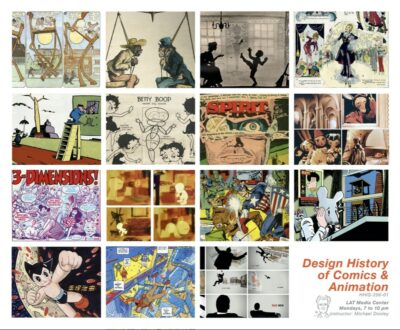
Michael Dooley:
Yeah. Well, in terms of transitioning, speaking of teaching, one of the last chapters was about teaching comics. And to redo that in 2020 we would work on doing research on the fact that you can now get Master’s Degrees in comics, which just didn’t exist in 2005. You now have places like the California College of the Arts and of course there’s James Sturm’s Center for Cartoon Studies, so you want to bring that in as well. And it’s worldwide, too. You’ve got the University of Dundee in Scotland. That’s wonderful. It was one of those things where- Just to continue along with what you were talking about in the politics of teaching it in this day and age, as I said, the inspiration for me to finally get up off my ass and propose a comics history class came out of the Charlie Hebdo- So this was 2015, okay.
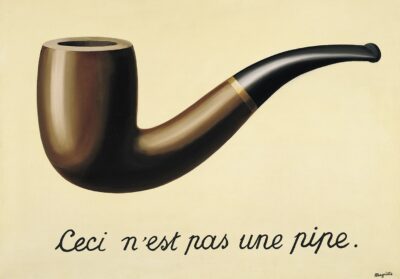
Michael Dooley:
So I asked the head of the department, who okayed it, fortunately, with relative ease, I’m happy to say. And right off the bat I said, “Okay, so in my syllabus, am I going to need to put a trigger warning?” And she scoffed and waved her hand. It’s like, “You know how to teach. Fuck that shit,” basically, is what she was saying. It was like, “You know how to handle it.” This is even pre- all the other stuff that’s going on now. And so, yeah, I pretty much know how to communicate with the students. There are certain sensitive areas. Well, it’s now “History of Comics and Animation”. And yeah, you’re going to talk about racism in comics, from Little Nemo to Bob Crumb, and animation. Just all over the place, from Little Nemo to whenever.
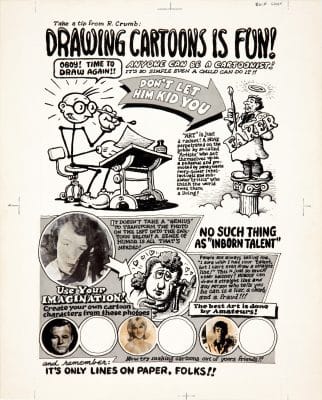
Michael Dooley:
So it’s- Basically, I will say to the students, “Okay, here’s what I’m going to show you. Here’s whatever it might be. Pictures of Muhammad.” When I announce that I’m going to be showing pictures that certain people are offended by, like the Muhammad cartoons, I usually like to, at that time, have a slide on the screen, a picture of Magritte’s This is Not a Pipe, to give it that kind of context. Or I could put the Bob Crumb quote, “It’s only lines on paper, folks.” [Alex chuckles] That sort of thing. But still, I can understand it. I can empathize with it. And it’s like, you go into stuff that we all have taken for granted. We’ve got to consider, we’re talking about 1950s horror comics. The treatment of women there is, it’s rough. And so, I’m pretty much happy to be a part of that. I’m also pretty much happy that nobody’s telling me that I have to be, that I have to do anything, that I have to follow these rules or anything like that. It’s just like, “Okay, I respect the kids, I’m conscious of what’s going on there. I take care of it.” And usually it’s like, whatever, take a 45 minute break and it’s not going to affect your grade at all. I completely understand. So to answer your question, there’s no problem there.
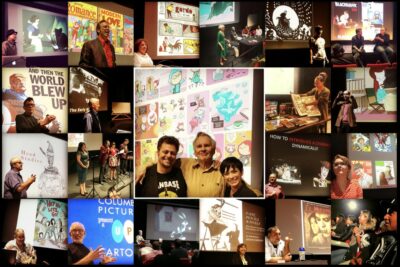
Alex Grand:
Mm-hmm (affirmative).
Jim Thompson:
Okay. Maybe just for a minute, talk about some of the guests that you’ve had come to your class.
Michael Dooley:
Oh. Well, some I’ve already mentioned, I mentioned Michael Gerber came to talk about his American Bystander. And in the course of that he also talked about the cartoons, focusing on the cartoons. And of course he was familiar with the New Yorker, so we got into that. And I’d really like to have him back to talk about his time in the ’80s where he resurrected the Yale Record, which was basically Yale’s equivalent of the Harvard Lampoon. And he made the point that, when it came to satirical college magazines, Harvard Lampoon’s specialty was putting out the writers and the Yale Record’s specialty was putting out the artists. And so I’m going to have him come back and talk about that.
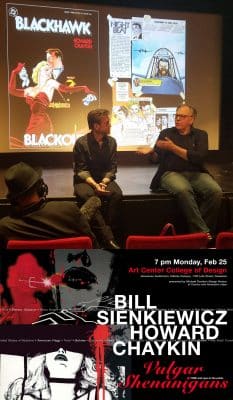
Michael Dooley:
But yeah, Howard Chaykin came to my class and just enthralled everybody. What I had done was, I had prepared a slideshow because it’s against my teaching religion to- if I’m teaching a history of design comics animation class – to not have at least one image on the screen at any given time. So basically what I did was, I did a Q and A with him and I prepared, basically I structured the questions and coordinated them with a slideshow. And so Howard was facing the audience. He was talking and as I was asking him questions about this and that – Flagg, Black Kiss, whatever – I would have the slides in the background. The students could see it, but Howard wasn’t even aware of it and it didn’t matter, that sort of thing. So that was cool.
Michael Dooley:
And he enjoyed it so much that he and Bill were at one point talking about putting on a show together. Bill Sienkiewicz. Then the question came up, Bill said, “Well, where would be a venue for this?” And Howard said, “Mike Dooley’s class?” [laughs]
Alex Grand:
There you go.
Michael Dooley:
And so, yeah, last semester they came and they just shot it up. We had to move to a larger room than my classroom because the crowds were-
Alex Grand:
Wow. That’s cool.
Michael Dooley:
The news got out on Facebook and people were writing on Facebook, “I’d kill to be there.” And it’s like-
Alex Grand:
That’s awesome..
Michael Dooley:
Yeah, there were so many. There were my students, of course, and they were the main core and the focus, obviously, so that these guys weren’t preaching to the choir. Because the main point is all about the students, as it is always with all these guest speakers. But still in all, there were people who were able to bring up other aspects, talk about Blackhawk or whatever, and that sort of thing. And like I say, with the slides, I had that. So that worked out great.

Advertisement
Michael Dooley:
I’ve had Scott Shaw come a couple of times and it’s always different, too. So, the first time he came he talked about his own work and the second time it’s like, “Well, I don’t want to-“ So I said, talk about your influences. And so he put together a slide show of the 13 most important people in his career, that sort of thing. And so, I know I already mentioned Mr. Fish, plenty of other- Oh, one thing just recently that happened that wasn’t even planned. I had Bill Morrison as a guest. He was editor of Mad at the end.

Alex Grand:
Yeah.
Michael Dooley:
And he had also just recently come out with a Yellow Submarine graphic novel that he put together. And it was like, we were talking about what to talk about and I said, “Well, the Simpsons is also an end of an era. Come talk about the Simpsons.” And so he came, he talked about the Simpsons, he had a slideshow. As usual, he did a great professional job. And! And, he brought along six guests. And! And one of the guests was Sergio.
Alex Grand:
Oh wow. That’s awesome. That’s great.
Michael Dooley:
Whoa, yeah. Come on. It’s crazy. So I can go on. Yeah. I haven’t even talked about all the people in animation as well, but just in terms of just what’s coming up, I’ve got another return engagement from a group of live performers called The Captured Aural Phantasy Theater, [Alex laughs] who perform regularly at Comic Con and various other venues. They are local. They’ve put on a show at my class. And coming up, it’s going to be on Valentine’s Day, so they are going to do EC Comics love stories.
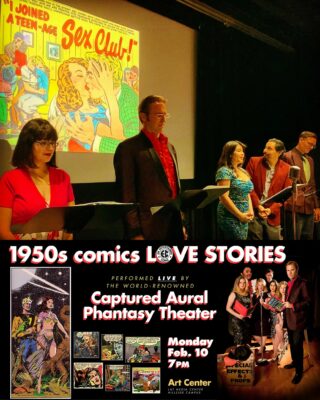
Alex Grand:
Oh wow. That’s great.
Michael Dooley:
And from all the genres, including crime, suspense, horror, sci-fi, and the rest of it.
Alex Grand:
Beautiful. That’s great.
Alex Grand:
You really approach your classes with creativity and passion. It sounds like you approach your classes as its own art form, in a way.
Michael Dooley:
Oh. Well, thank you. Yeah, I appreciate that compliment.
Michael Dooley:
And they’re watching a radio play, because this theater troupe brings their own vintage 1930s microphones. And they have a table set up for sound effects and everything like that. It’s just incredible. Last time they did one presentation and it was like, “I’d like to have you back.” And Ben {Dickow], who heads it up, said, “Oh, what would you like us to do?” And I said, “You available in early February? How about EC Comics Love Stories?” And he was like, “Yeah, that sounds like fun.”
Alex Grand:
Real fun.
Michael Dooley:
So he did that. They’re putting that together, even as we speak. Then I have another one, just to talk briefly about animation, there’s a documentary feature on the Spike and Mike Sick and Twisted Animation Festival, that started the careers of-
Alex Grand:
Oh yeah, yeah, I like that. Yeah.
Michael Dooley:
– a whole lot of people. And in the documentary they’ve got, among the talking heads, Will Vinton, Bill Stout, Weird Al, Bruno Bozzetto from Allegro non Troppo, Bob Kurtz, Marv Newland from Bambi Meets Godzilla. Anyway, so the director is coming, she’s going to screen this film, which is actually set up to premiere at the Slamdance Festival. So it’s just, like, breaking out now. She’s going to come along and she said she’s going to bring along some of the people, some of the local people who were in the film to talk about it. So that’s-
Alex Grand:
How fun.
Michael Dooley:
Yeah. I mean I’ll stop there. But that’s two of the people from this coming semester that I’m really excited about.
Alex Grand:
That’s great.
Michael Dooley:
It’s actually two groups; an eight-person theater group and a four, six, eight-person screening of the Spike and Mike film. Anyway-
Alex Grand:
That’s awesome.
Michael Dooley:
Guest speakers.
Alex Grand:
First, great set of guests, great instruction. And I love the passion. You have such great passion for this. It’s really great.
Jim Thompson:
And you were talking about EC and stuff. I know you have a bunch of things, Comic Fest and other activities, but let’s limit it to the one that you are most excited about, [Michael laughs loudly] coming up at WonderCon. And I don’t know anything about it. Tell me about what’s happening?
Michael Dooley:
Yeah. Bullshit. [chuckles] Yes. It just so happens that among the presentations that I’m giving in 2020 is- Basically it’s a- What would you call it? Seduction of the 1950s comics? I’m doing a panel with Sydney Phillips. She’s an expert on romance comics of the 1950s. And then another guy- God, I forget. What the hell? Let me look. Oh, Jim Thompson!
Alex Grand:
Yeah!
Michael Dooley:
Jim Thompson is also going to be doing something on EC comics. And this Jim Thompson guy, he’s so much of an expert that I’ve been putting together a flyer for my EC Comics Love Story for my class. I’ve been going to him for advice and he has gotten me some great panels that I’m going to be including in the flyer, in the poster. And I’m going to be talking about another aspect of the 1950s comics.
Jim Thompson:
So, anybody that’s going to be at WonderCon, please come see us. We’re going to be presenting a panel around the theme of seduction, and it should be in comics of that 1950s era, and it should be great fun.
Michael Dooley:
It will be. What do you mean, “Should be?”
Jim Thompson:
So that’s WonderCon. I want to talk about Comic-Con for a minute, and what your role is going to be in that- I’m just going to say the word “Eisners”, and then you’re going to tell us what you are, and what you can say, without talking too much about the subject, because I don’t want to get anyone in trouble.
Michael Dooley:
[laughs] And the winners will be- But I’ll have to kill all your listeners first. No, no, no. It’s nothing like that. The Eisner Awards, as usual, will be given on Friday, July 24th. Just a couple of days ago, Jackie Estrada put up the announcement saying that it’s time for artists, publishers, comics’ people to submit their entries in the 30-something categories. And with those entries, I and five other people are judges. And I’m very honored to have been chosen as one, and I’m among a great group, a fantastic group, one of whom I knew already, Jamie Coville.
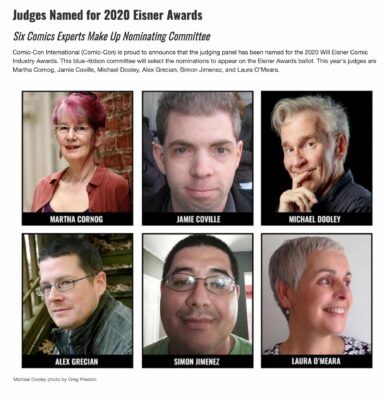
Michael Dooley:
He’s definitely into comics’ history. He’s been writing about comics’ history for about 25 years. And anybody at Comic-Con has probably seen him, because at the panels, he’s the guy that goes up with a tape recorder to the dais and asks them if it’s okay to be recorded. And for the past 15 years he’s been posting not only San Diego Comic-Con, but all sorts of panels, and whatever Comic-Con he can get to; and posts them online at thecomicbooks.com. So, definitely worth checking out.
Alex Grand:
Really nice fellow, too.
Michael Dooley:
He is indeed. Oh yeah, he’s a sweetheart. And the others I’m looking forward to meeting with. We’ve been corresponding, but – as it mentions in the official announcement that’s been posted – we judges will be meeting in San Diego in late March and actually be doing the real heavy lifting. Right now we’re doing a whole lot of prep. Anyway, the other four are Martha Cornog, Alex Grecian, Simon Jimenez and Laura O’Meara. And dealing with them electronically has been nothing short of a delight. I can’t imagine a better group of judges that I’d like to be with. And they all are coming from such different perspectives, and they all have smart attitudes about comics in different ways than me. So I am so looking to, not only getting to know them, but also getting enlightened to their perspectives. It’s just going to be a blast, as far as I’m concerned. So I’m really looking to what is basically, in reality and literally, in the literal sense of the term, a once-in-a-lifetime opportunity.
Alex Grand:
Oh, yeah. This is a fun, huge milestone, and well deserved. You’ve contributed a lot in various forms just to graphic design, analysis, commentary, your classroom, your students, you’re a historian, you’re an artist. We’re really impressed with your work and we’re really glad that you listen to our podcast as well. And I’ve been really-
Michael Dooley:
I’m honored to be a part of it as well.
Alex Grand:
Well, thank you. And honestly, you being an Eisner judge is well-deserved. I congratulate you for your life achievements as well as your future achievements. And this is one of them.
Jim Thompson:
Your place in comics’ history will be cemented forever if you could move Alex and I from the bleachers at the Eisners over to the table section. [Michael laughs loudly]
Alex Grand:
There you go. Exactly.
Michael Dooley:
Yeah. I think the judges have a certain amount of pull, but when it comes to seating, I don’t know. I’ll probably have to bring my own chair myself. But the good news about it is, when the three of us actually get “The Education of a Comics Artist, Volume Two” published, then I will have an inside connection to the Eisner awards.
Alex Grand:
There you go. I like it.
Michael Dooley:
Think about that.
Jim Thompson:
I’m ready to go.
Michael Dooley:
I’m not saying anything, but-
Alex Grand:
Right. No problem. My finger’s on my nose.
Michael Dooley:
[laughs] To God’s ear.
Alex Grand:
To God’s ears, yes. [chuckles] So this has been a fun episode of the Comic Book Historians podcast with Alex Grand and Jim Thompson. We’ve really enjoyed Michael Dooley’s work for a long time now. We’ve actually, through a process, just through online, we’ve actually become friends and we’ve hung out in person. We’re privileged to have you on the show. Thanks so much for being here.
Jim Thompson:
Thanks Michael.
Michael Dooley:
Thanks to the both of you.
© 2020 Comic Book Historians
